Burhanpur, Chikhaldara, Nagpur & Admednagar
The below travelogue is an itinerary of round trip to Nagpur from Pune. We took an extended route to Nagpur via border towns of Maharashtra – Burhanpur and Chikhaldara. From Nagpur, we did a day trip to Pench National Park and Ramtek. While returning from Nagpur, we stopped at Aurangabad to break the journey and explored Ahmednagar Fort on our way back to Pune. The trip was done during December 2023 and we covered about 1700 km in the span of 9 days.
Having covered most of the popular destinations in Konkan, North (Khandesh) and Western Maharashtra, we planned for a road trip the to the unexplored Eastern Vidarbha region during 2023. On this trip, the destination was the main city of this region – Nagpur
Road Trip to Prerequisites
There are certain things to keep in mind before planning a road trip in India. You can read my below blog for a few tips.
Trip Planning
1) Point of Interests (POIs): After reviewing several online blogs and travel portals, we zeroed down to the below points of interest for this trip.
- Burhanpur: Shahi Kila, Black Tajmahal, Dargah-E-Hakimi, Asirgarh Fort
- Chikaldara: Panchbol, Hurricane, Mozari, Devi, Bhimkund Points
- Nagpur: Ambazari Garden, Deekshabhoomi, Shri Ganesh Mandir Tekdi, Raman Science Centre, Gandhisagar Lake, Narrow Gauge Rail Museum, Itwari Market, Pench National Park, Shantinath Digambar Jain Temple, Ramtek Temple, Dragon Palace Temple
- Ahmednagar: Ahmednagar Fort
2) Itinerary:
Nagpur is about 750 km from Pune and takes 11 hours of drive via the newly built Samruddhi Expressway. We took a detour from the expressway to include Maharashtra-MP border towns – Burhanpur and Chikhaldara. From Chihkaldara, we were to travel Nagpur and explore the adjoining Pench National Park and Ramtek. Return journey from Nagpur was planned via Samruddhi Expressway and take a night halt at Aurangabad and explore Admednagar Fort before reaching Pune.
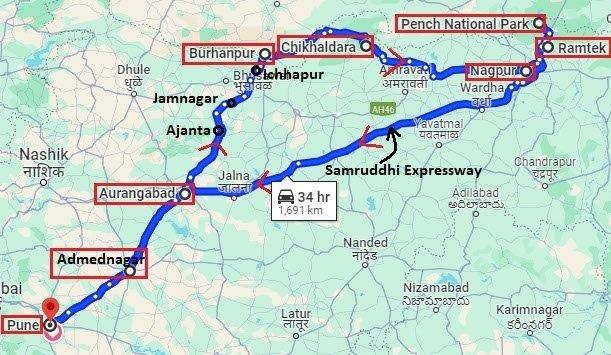

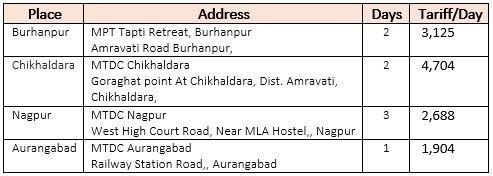
2) Hotels Booked:
On this trip we booked all of our stays with state tourism hotels. We booked MPSTDC (MP Tourism) for Burhanpur and MTDC (Maharashtra tourism) for Chikhaldara, Nagpur and Aurangabad. The reservations were done 2 months in advance via their respective portals – https://mpstdc.com/ & https://www.mtdc.co/en/
The Journey
Our ride was petrol variant – Maruti Swift Dezire with 1197 cc engine. My fellow passengers were 2 kids and my wife – who was to take turns to drive.
Day 1: Pune to Burhanpur: 446 km. 10 hours
The first leg of our journey was going to be the longest one of this trip. We were to travel about 450 km with an ETA of 10 hours. Assuming 3 or 4 breaks, we estimated about 12 hours to reach Burhanpur.
In spite of our best efforts to leave early by 6 am, it was 7:15 when we checked out of our society. The route to follow was Wagholi >> Shikrapur >> Shirur >> Ahmednagar >> Aurangabad >> Ajanta >> Jamner >> Ichhapur .We passed through early morning traffic without much challenge except a few usual snarls at Wagholi. We feared the omnipresent traffic jam at Shikrapur but were lucky to find a hassle-free traffic on that particular day.

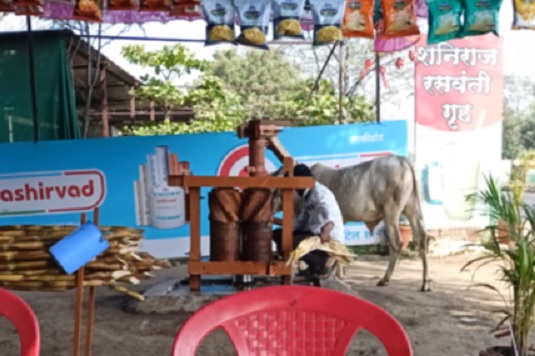
By the time we crossed Shirur, it was 9:30 am. The first stop was at ‘Shivneri Misal’. After a sumptuous South Indian breakfast, we carried further on with our journey. While passing by Ahmednagar you cannot ignore the sugarcane juice vendors on both the sides of the highway. Most of these shops deploy bullock driven crushers to extract the juice. This ingenious way is unique to this region.
A fifteen minute ‘cane juice break’ allowed us another breather to stretch our legs. By noon, driving past Aurangabad and crossed Samruddhi Expressway. For Nagpur, we would have taken the Expressway, but since we were taking a detour, we drove past the expressway towards Ajanta. Back in 2014, while visiting Ajanta caves, this stretch used to be a narrow 2 lane road. Now it was widened to a 4 lane concrete road. Though the work was ongoing on certain patches, its condition was much better than it was 9 years back.
For lunch we stopped by – Shree Hotel Saiprasad Restaurant. Nothing fancy but the place offers some decent food. We ordered veg. thalis which did not disappoint. It was 2 pm by the time we finished lunch.
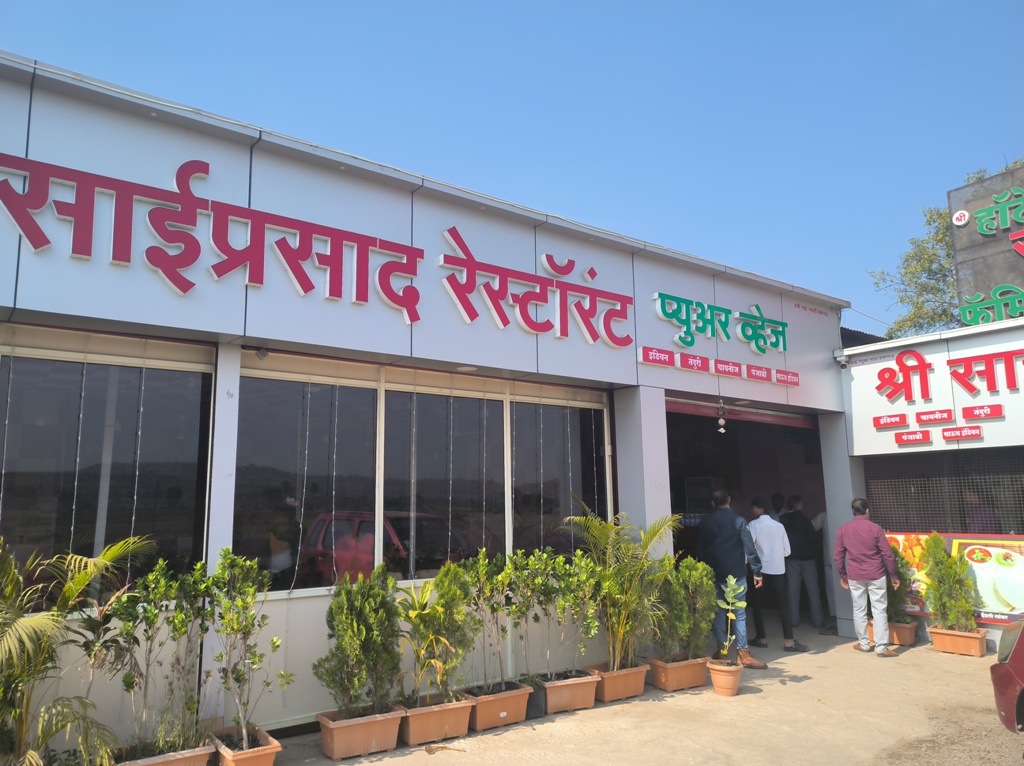
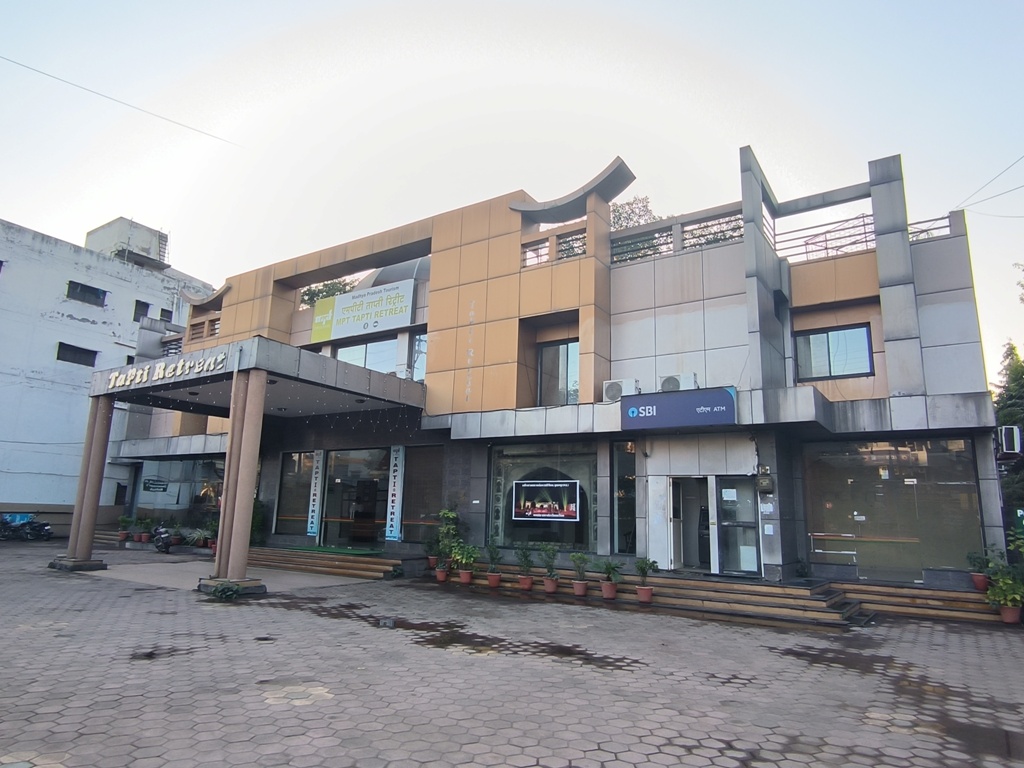
Burhanpur was still 4 hours away and our reluctance of driving after sunset ensured that we did not take any more breaks.
We drove past Sillod and Ajanta to reach Pahur where we joined National Highway 753L. Driving further to Bodwad, we entered Madhya Pradesh to reach Ichhapur. A few more minutes of drive made us cross river Tapi (or Tapti) and by 6 pm we were at resort.
The MPT Tapti resort is located next to highway 753L (NH 3) which leads to Indore. It is spread across huge space. It also has a restaurant offering a decent variety of bit overpriced dishes. Late in the evening, after unpacking and unwinding ourselves, we decided to check on nearby restaurants when we came across – Hotel Gurukripa which was 5 minutes walking distance. The restaurant seemed to have a good footfall so we decided to try it for dinner. We went with safe and sure options of – Veg Thalis which were prepared hot and fresh and did not disappoint. After dinner we were back to our Hotel. Having spent almost an entire day driving we were dead tired and crashed to our beds.
Day 2: Explore Burhanpur
Founded in 1400 AD, the historical city of Burhanpur was once the capital of the Mughal Kingdom. It was an important outpost of the Mughals and was known as the gateway to southern India for its strategic location. Burhanpur does not makes to popular tourist destinations but is famous for its textile industries and is the hub for Power Loom industry in Madhya Pradesh.
Our plan for Day 2 was to head out and explore Burhanpur’s attractions and landmarks. We had a hearty breakfast at our resort’s restaurant before setting out for our Day 2 itinerary.
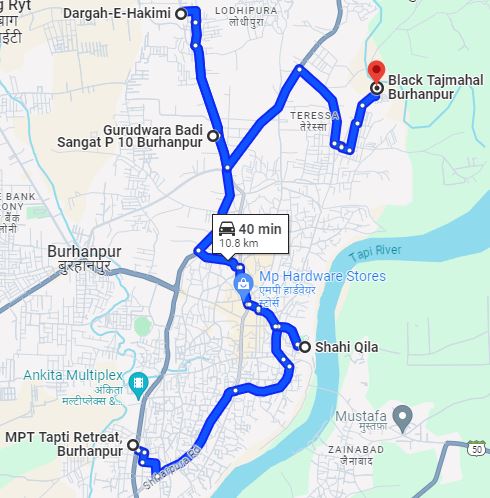
We started our day by driving to the most popular attraction – Shahi Kila. The road to the fort passes through very narrow and congested lanes of the old city. The GPS was not helpful as it kept moving round in all directions. Ultimately, we had to ask help from locals. Luckily one of the gentleman escorted us to the entry of the Fort on this bike. If you plan to visit this place, please avoid driving and take an auto rickshaw instead.
There is an entry fee of ₹25 for the Fort which has to be paid online via the MPT app. Now in ruins, the fort is located east of the Tapti River. It was built by Farooqui rulers and lived in by Shah Jahan while he was governor of Burhanpur. He spent a significant amount of time in this city and contributed to the development of Shahi Qila. The Shahi Hamam, or royal bath, built for his wife, Mumtaz Mahal.
One of the fascinating facts is that the Taj Mahal was originally planned to be erected in Burhanpur but due to unavailability of white stone it was built later at Agra. Mumtaz, later died in Burhanpur during child birth.
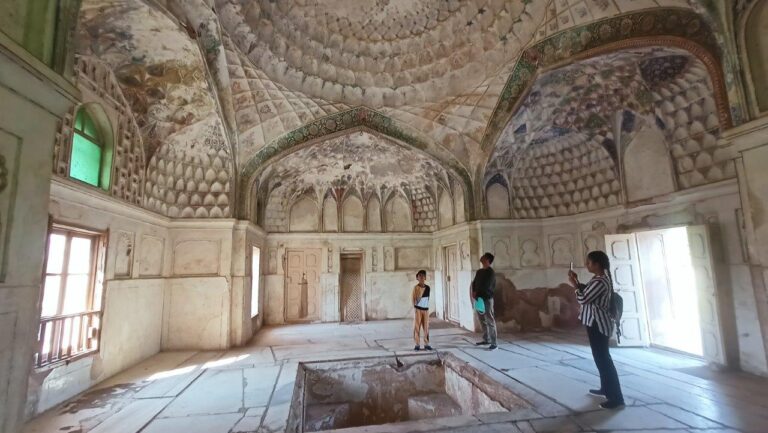
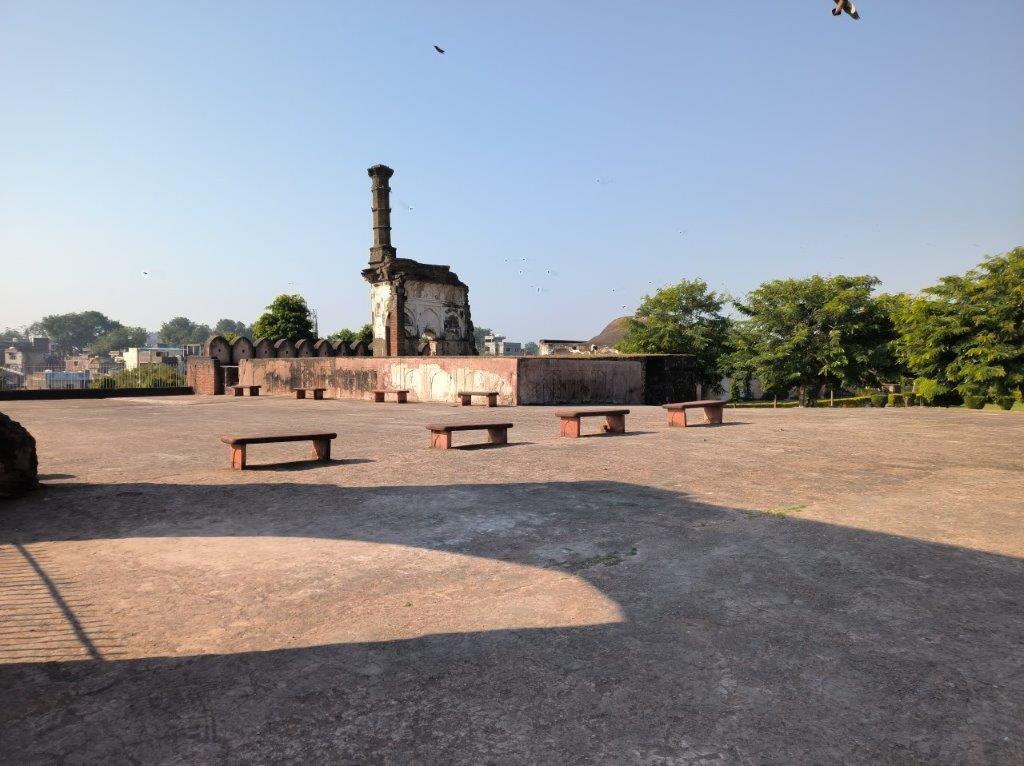
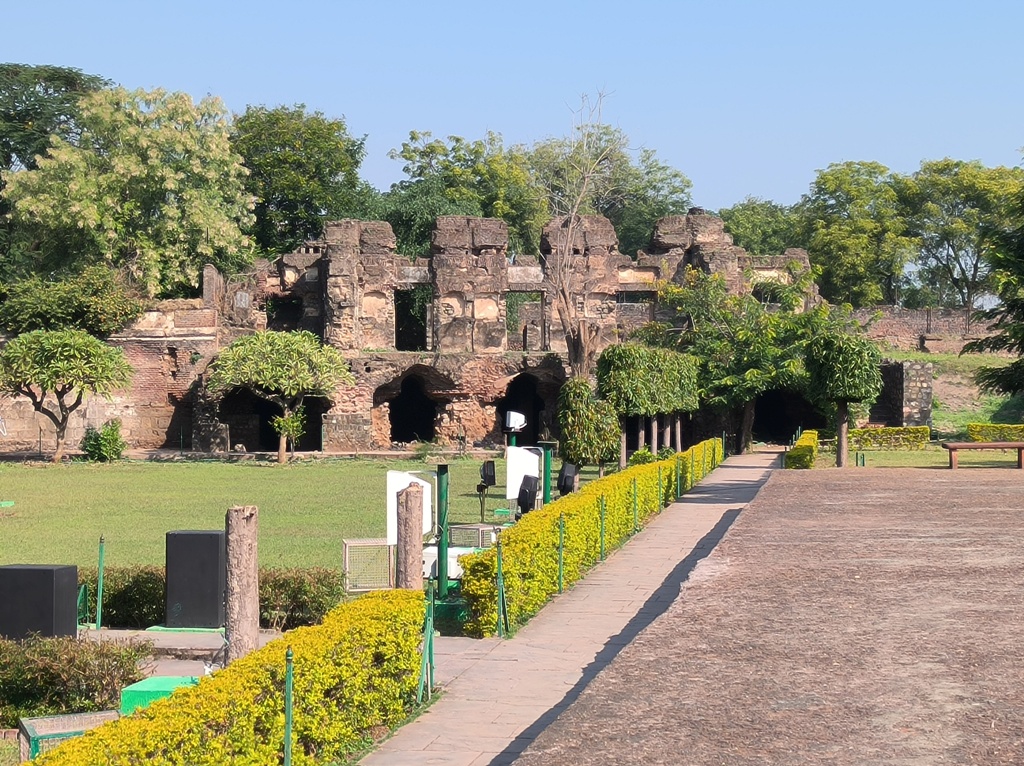

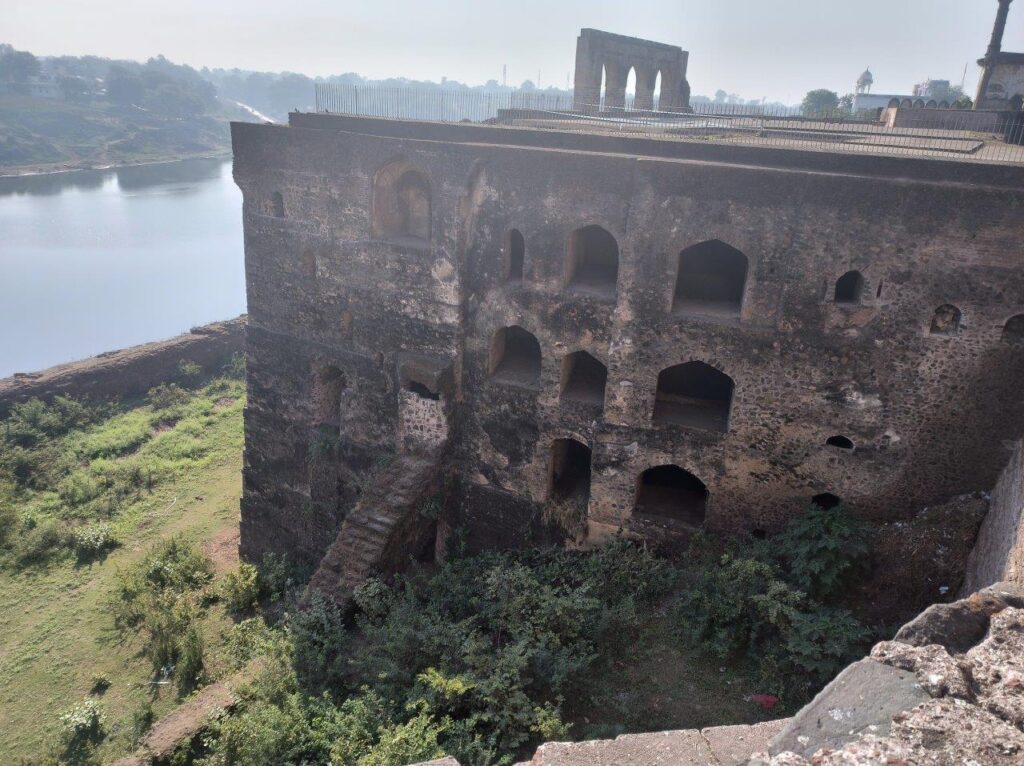
We spent an hour at the Fort. The next monument in our list was ‘Black Tajmahal’. Though it is hardly 3 km from Shahi kila, the GPS was again unable to find the way through the narrow lanes of the old city. After navigating through several turns and asking for directions we finally arrived to the ‘Black Tajmahal’
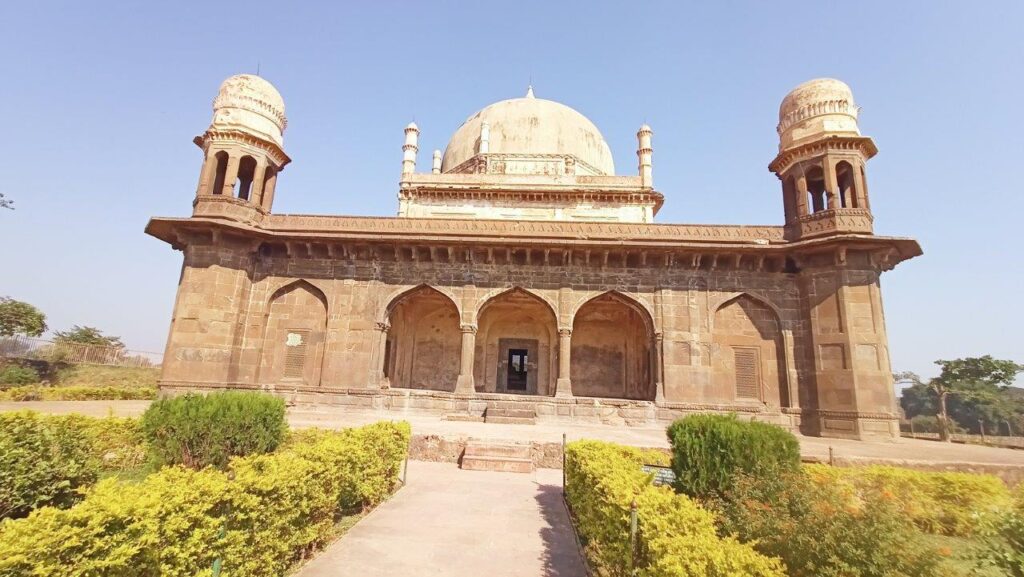
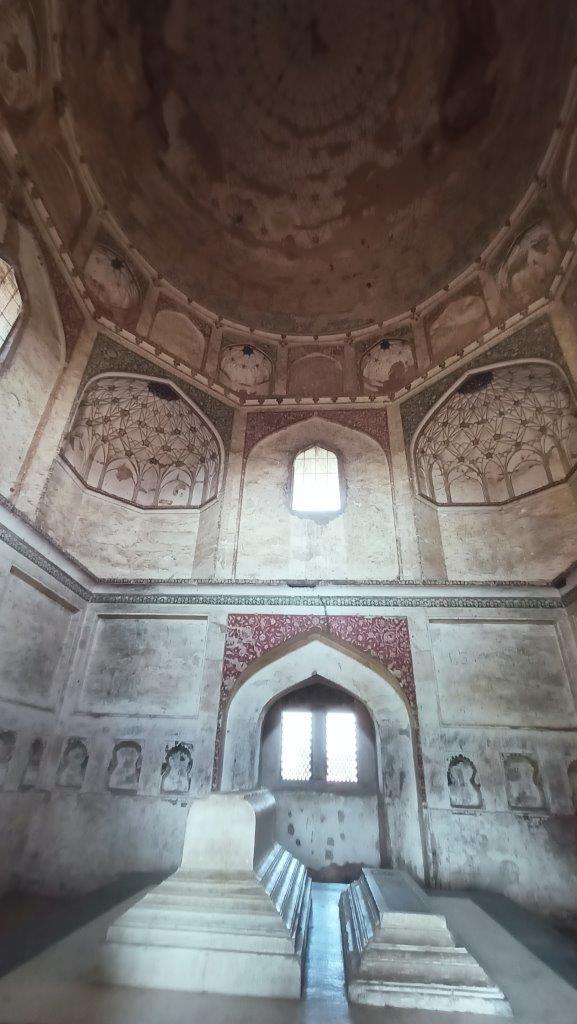
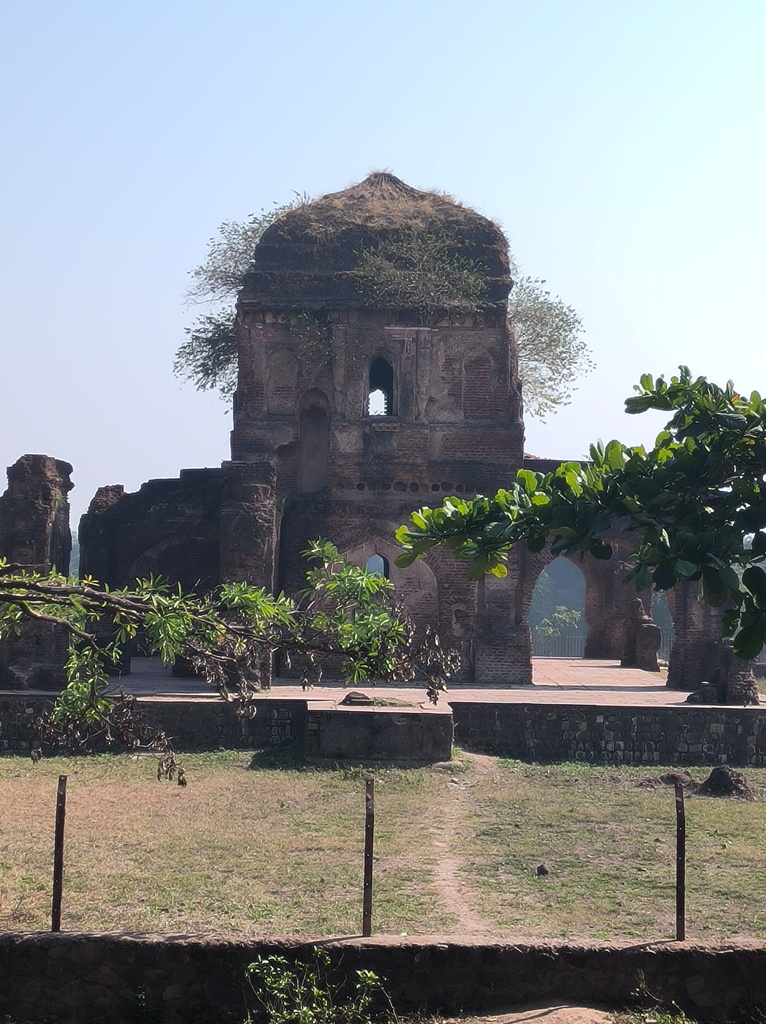
The monument is inherently the Tomb of Shahnawaz Khan who was a commander of the Mughal army. It was built by his father who was Mughal subahdar (governor) of the Deccan. It is called ‘Black Taj Mahal’ as it is made of locally found black-colored stone and is shaped like the Taj Mahal. Surrounded by a garden, the monument is square in shape with a central dome and has verandas running all around it. Next to it is a ruined monument called Paandan Mahal because it is shaped like a ‘paandan’.
After connecting with the history and heritage of Burhanpur, it is now time to connect with the spiritual side by visiting Dargah-e-Hakimi. The Dargah is 4 km from ‘Black Taj’ and can be easily driven by car. On the way to Dargah, we passed by ‘Gurudwara Badi Sangat’. Though the Gurudwara was not part of our itinerary, the magnificent entrance of the Gurudwara made us pay a visit.
Visit to a Gurudwara is incomplete without having langar (free food served by volunteers). We joined the community dining hall and had a few bites of simple cooked daal-roti-chawal.

A kilometer away from Gurudwara is Dargah-E-Hakimi. The Dargah is one of the holiest places for the Dawoodi Bohra Muslims. It was constructed in honor of 17th century Saint Syedi Abdulqadir Hakimuddin. Thousands of Bohra pilgrims visit his shrine to pay their respects and ask for the saint’s blessings.
The Dargah is constructed in pure white marble, making it an outstanding example of Mughal architecture. It has an ample free parking space and a beautiful park. The entire vicinity is so well maintained that the locals refer to it as ‘Chota Amreeka’.

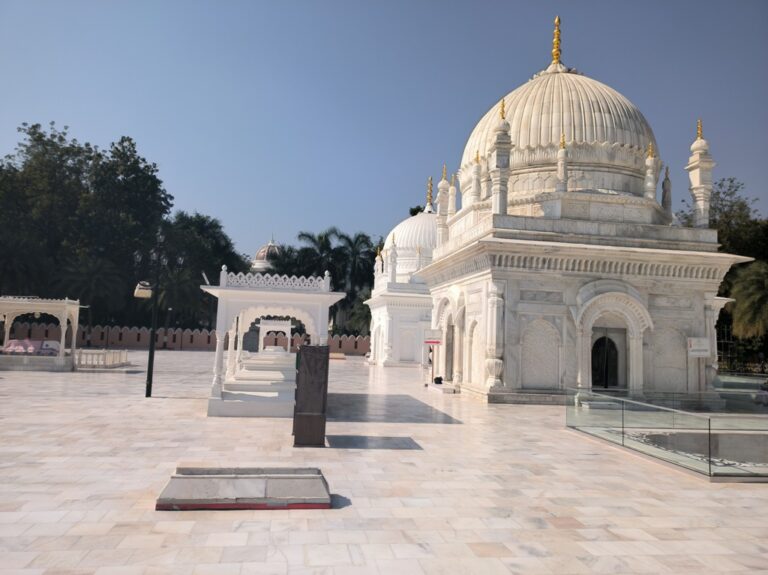
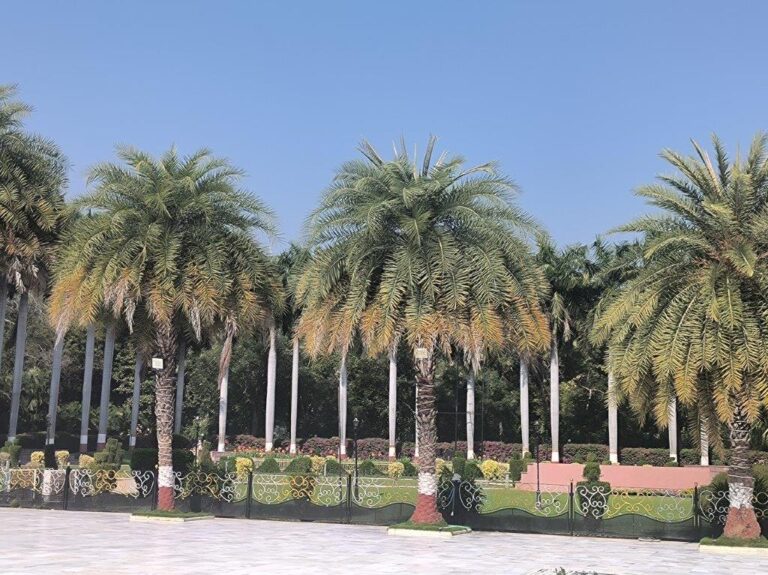
It was 2 PM and we were done exploring all the major attractions of the city. By this time we were famished and it was time to grab some lunch. When we inquired for a good non-vegeterian restaurant, we were suggested to try ‘Rehmania’ which is close to Jaisthambh Chourah. Based on our driving experience in the old city, we left our car at the hotel and took an auto. The restaurant was a 10 minutes’ drive. We asked for recommendations and were suggested to try – Chicken Red Cook. We went ahead with suggestion and topped our order with Manda Roties and chicken biryani.
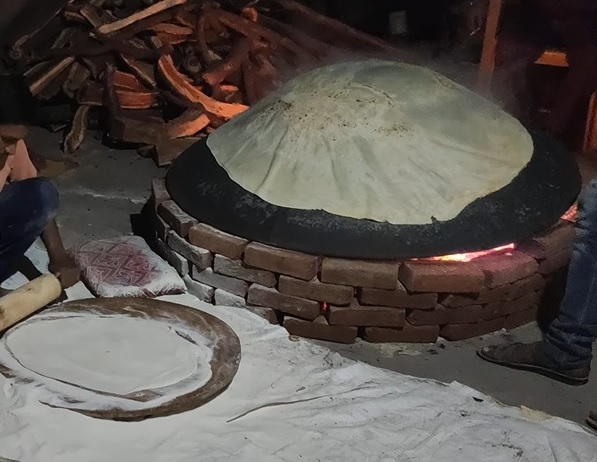

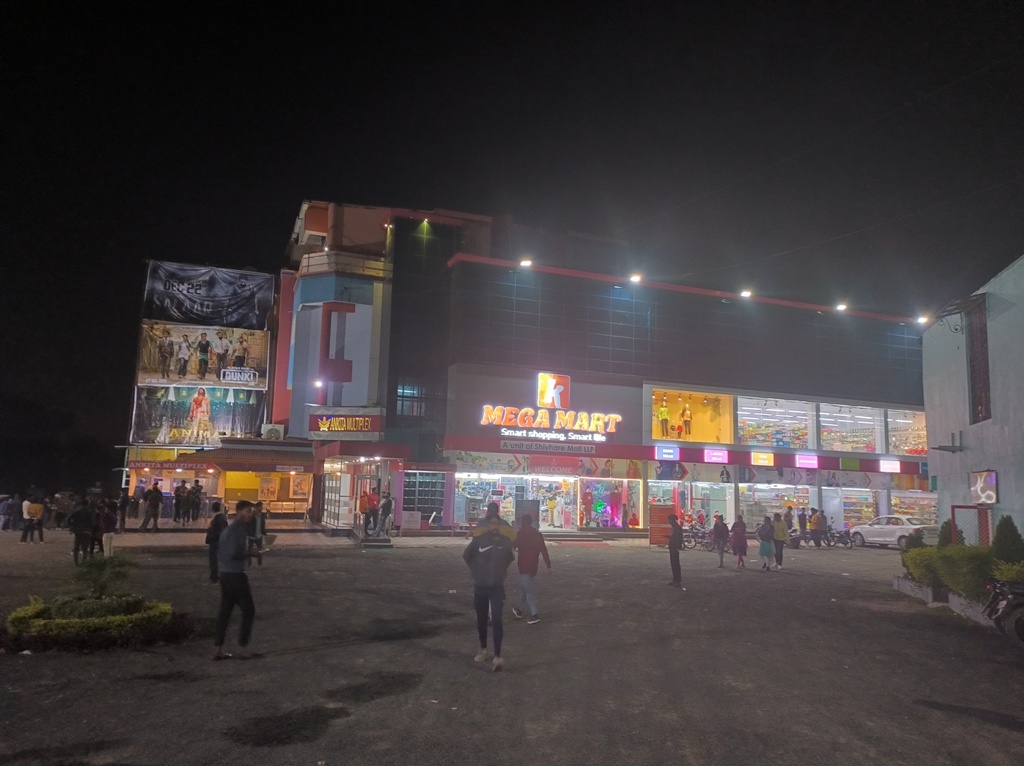
Manda roties are another USP of Burhanpur. It is similar to roomali roti but with a bit different taste and bigger in shape. During Mughal period, Burhanpur was an army cantonment and soldiers came here from every corner of India. Cooking more food in less time was a challenging task, so the cooks started making large size bread called Manda. Earlier one roti used to weigh 500 grams but now bread’s size has become much smaller but despite this, it is still much bigger than an average roomali roti.
Our order unfortunately turned out to be a damp squib. The ‘Chicken red cook’ was too oily with a bland taste. The Manda roti was cold and chewy. We later realized that Manda roties are not made in the restaurants. There are dedicated shops which prepare them and supply to the restaurants. Chicken biryani was yet another disappointment. It was plain white rice cooked with chicken gravy.
A bit let down, we found solace on finding a few shops selling Burhanpur’s another famous specialty – mava (khoya) jalebi. As the name suggests, it is made from condensed milk. Only difference is that it is softer and dark colored than the normal jalebi and tastes somewhat like ‘gulab jamun’.
Having an entire evening at our disposal and nothing else to do, we decided to end our day with a movie. Walking distance from our hotel was – Ankita Multiplex which was playing Shahrukh Khan’s starrer – “Dunki”. We enjoyed the show with popcorn and on our way back to hotel had dinner at Hotel Gurukripa Restaurant.
With a bad lunch experience we decided to play safe and ordered ‘Daal khichri’ which was prepared hot and fresh.
This ended our Day 2 itinerary. We got to experience the history and heritage of Burhanpur along with connecting with its spiritual side.
Day 3: Visit Asirgarh Fort (which we couldn’t) and drive to Chikhaldara (one hell of a drive). 196 km. 5 hours 30 Mins
We still had Asirgarh Fort left to explore in our checklist for Burhanpur. The fort is about 25 km North of Burhanpur. Built by the Asa Ahir of the Ahir dynasty in the 15th Century, the Fort is now in ruins. It used to hold strategic importance during Mughal era because the Fort demands a pass through the Satpuras that connects the valleys of the Narmada and the Tapti Rivers, which is one of the most important routes from North India into the Deccan. During the Mughal era, the fort was popularly known as ‘Key to the Deccan’ and it was widely agreed that the Deccan started from here, while the area that lay between Asirgarh and Delhi was considered to be Hindustan. The fort also has a legend, according to which it is haunted by the presence of Ashwatthama – The ill-fated warrior prince from the epic Mahabharata who was doomed with a curse by Lord Krishna that he will remain immortal with no one to care and care for!
We had planned to visit it on way while driving to out next destination – Chikhaldara. This way we would have saved to-and-fro drive journey from Burhanpur. We checked out from the hotel early morning after a complimentary breakfast. We drove though NH753L and half an hour’s drive brought us to a diversion leading us to the Fort.
From here, a narrow track of road takes you till the Asirgarh fort which located on top a hill. We found the road too narrow to fit in just one car. With no guard railings along the road, a slight wrong maneuver would have send the car toppling down the hill. With no soul in sight, it seemed like we were the only people on the narrow passage. Probably the ‘haunted’ tag, deterred people from visiting this place. The road had several patches of broken and washed away tar. Mid way, we came across huge rocks from a fresh land slide partially blocking road. The sight made us lose confidence to carry on any further. Driving with family in such situations makes you anxious and the first thing with comes to you mind is everyone’s safely. We decided to abandon driving any further and return back to the base. With several back and forth maneuvers, I managed to reverse the car. We all took a sigh of relief once we reached back to the base from where we had started.

After giving a slip to Asirgardh Fort, we configured Goople Maps for our next destination – Chikhaldara. The GPS shows two routes – First via Gudikhera and second via Nepanagar. Both of the routes meet at Dedtalai which leads to Chikhaldara. Though Google was suggesting the first route, we took the Nepanagar route as it was 10 km shorter. This proved to be another blunder of the day. The route passes through villages with beautiful banana plantations, but unfortunately Google maps was not stable. The route was not updated on my satellite based MapMyIndia device, so even it did not help. With breaking internet connectivity, GMaps made us take several diversions and turns.
We came across the bridge over Tapi River with water overflowing over it (red circle in the map). Though the flow of water was not that strong but the bridge was without any side railing. A small slide of the car would have taken us straight into the river. I spent almost 5 minutes watching other bikes and cars crossing the bridge but could not muster courage to cross it. Finally we all agreed to drop the idea and take an alternate way.
When technology fails, you need human intervention, so we turned off the GPS and inquired a few locals for directions to Dedtalai. Luckily, we met a family who were driving in that direction. We followed them through narrow and dusty village roads via Amlakhurd (black colored route in map) to Dedtalai. We finally got to cross the Tapti River over a proper bridge and entered Maharashtra.

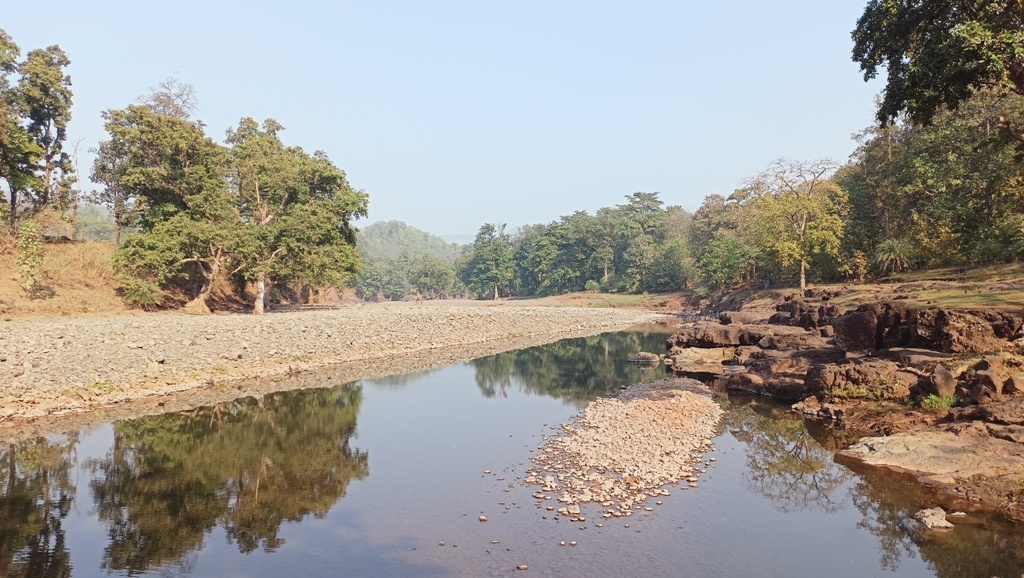
From here the road takes SH6 and passes via Dharni >> Harisal and enters the Melghat Tiger Reserve. The drive via this route is a treat to eyes with greenery on both sides.
It was 3 pm when we crossed the bridge over Sipna river and reached Melghat Tiger Reserve Tourist Complex at Semadoh.
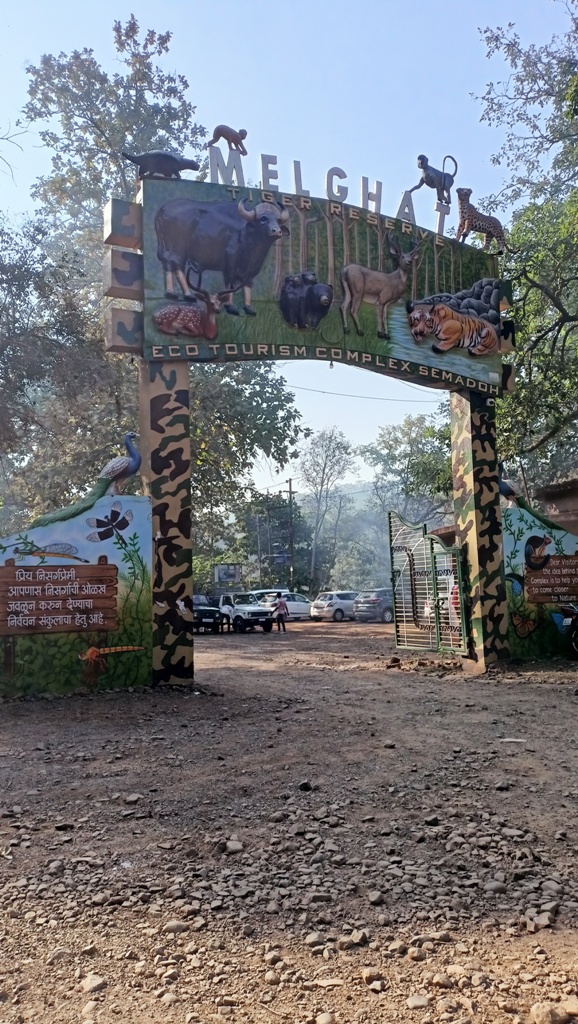
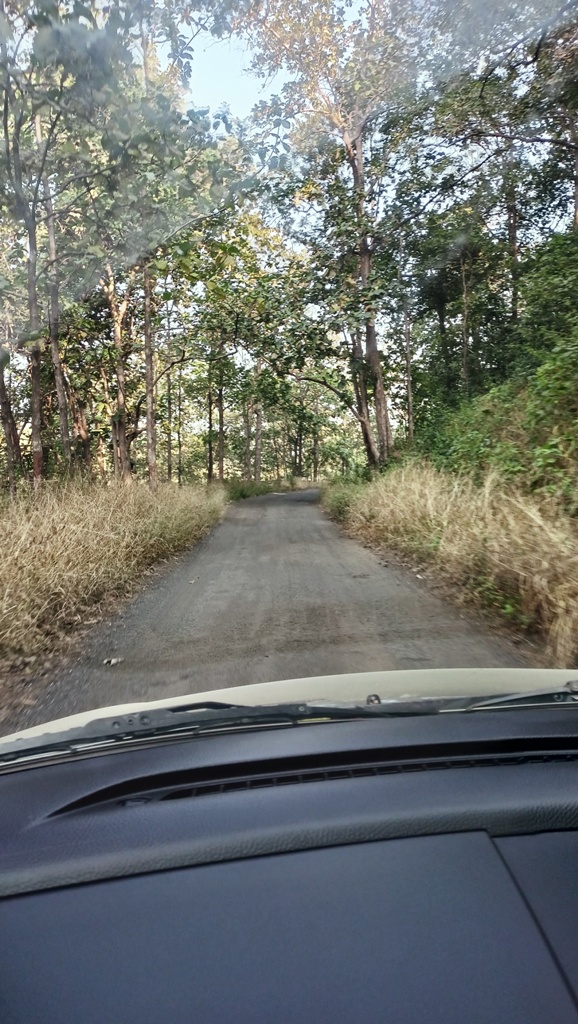
We did not get a chance to have lunch on this eventful day as most of the route passed though villages and forests. We searched for restaurants at Semadoh but did not find good options.
Our hotel was still 25 km and the drive was through mountainous forest range, so we decided to skip lunch and head towards Chikhaldara. We wanted to avoid driving after sunset at all cost.
Semadoh to Chikhaldara drive is another one to remember for lifetime. The road is broken, patchy and single lane but drives you through mesmerizing thick green forests with arrays of sun light beaming through trees.
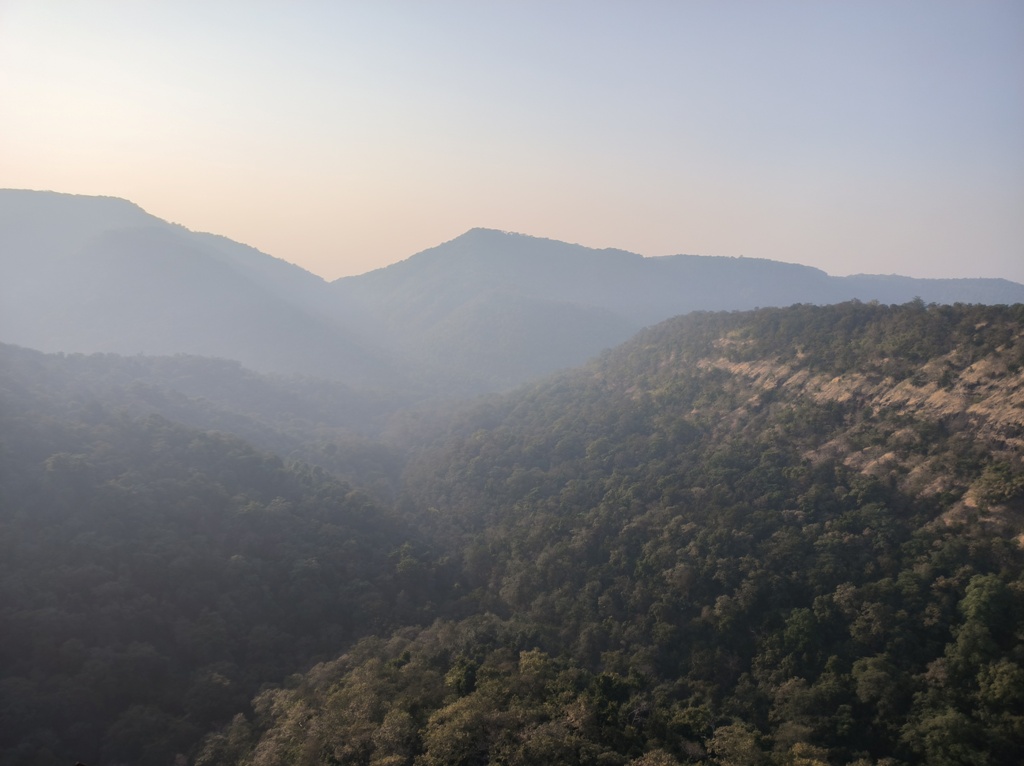
5 km prior to Chikhaldhara is Panchbol point. The plan was to explore this point on the way, else we had to return back to visit it. Panchbol point provides a panoramic view of the surroundings where 5 hills come together to form a deep valley. The Point has acquired its name from the belief that if you shout anything, you can hear the echo back not once but five distinct times. Consequently, the name ‘Panchbol’ – which means Five Echoes.
After spending a few minutes and clicking pictures, we carried on our journey to our Hotel.
Before entering Chikhaldara, we were stopped at the forest department’s check post to pay the entry fee of ₹260 (₹100 for car and ₹40 per passenger). When we reached MTDC resort, we were famished. Since it was early for dinner, we stepped to resort’s restaurant and learnt that the only available option was ‘kanda bhajia’ (onion pakodas) with tea. Within a few minutes we cleared 2 plates of ‘bhajiya’ with tea which gave us some relief from hunger.
To spend our evening we walked to nearby attraction – Hurricane point. Close by is another attraction – Balancing stone point, which has 9 stones aligned on top of each in a perfectly balanced fashion. It is a good place for to take selfies. On the opposite peak a ropeway tower was in process of being constructed which looked beautiful against the backdrop of setting sun.

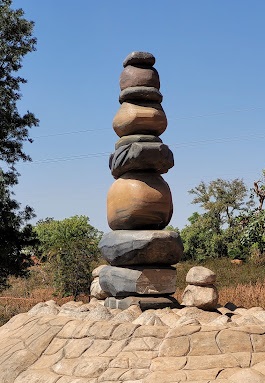
We had dinner at Hurricane Garden Restaurant, which is near Hurricane Point. The options were more than what MTDC offered.
We had started our day with a failed attempt to reach Asirgarh Fort and return half way. We then lost our way to Chikhaldara and had to take several diversions to find the correct route. The drive via Melghat Tiger Reserve, passed through narrow roads of dense forests with no one in sight. Day 3 was perhaps the most (mis)adventurous day of the entire trip.
Day 4: Chikhaldara
Most of the hill stations in Maharashtra lie in the Western Ghats with an exception of Chikhaldara which is in the Satpura Range. Located in the Amravati district, it is home to Melghat Tiger Reserve, which is one of the important tiger reserves in India. It is also the only place in Maharashtra which grows coffee due to its cool climate and suitable soil conditions. Like any other hill stations in India, most of the attractions in Chikhaldara are mountain ‘view points’ which offer panoramic views of the surrounding valleys, dense forests, and lakes. We were visiting the hill station during December but most of online reviews recommend monsoons as the best time to visit Chikhaldara. Also note that there are limited options to stay here, so book your accommodation on advance.
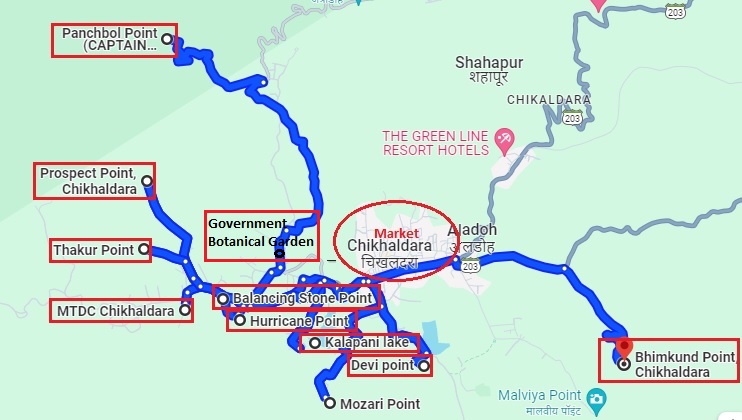
Plan for the day was to explore Chikhaldara starting from the farthest point – Bhim Kund and end with the Prospect Point which was walking distance from our MTDC resort. We followed the below sequence for the day – Bhim Kund >> Devi Point >> Gawilgarh Fort >> Kalapani Lake >> Botanical Garden >> Prospect Point
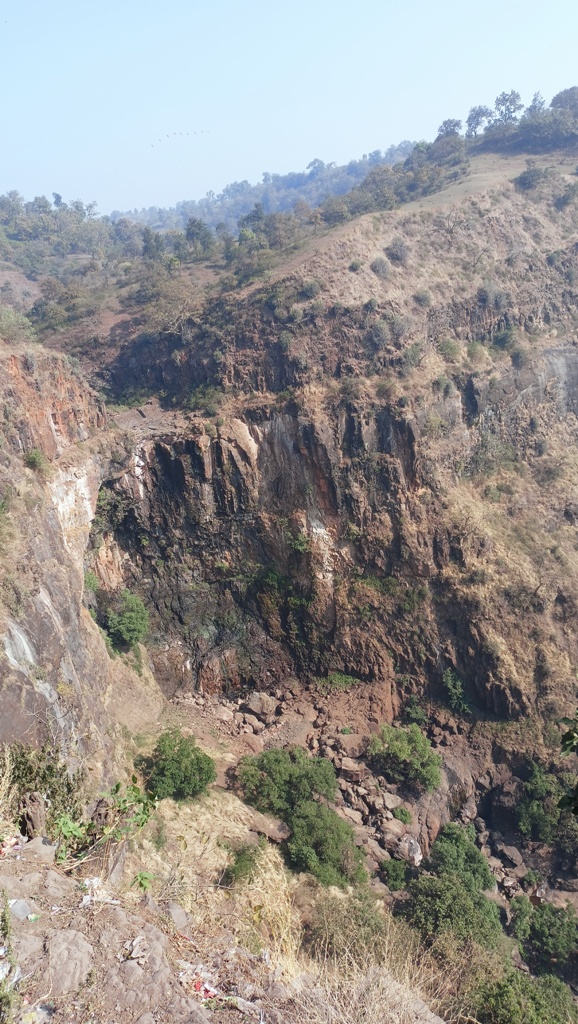
Bhim Kund – Bhimkund is 6 km drive from MTDC resort and takes about 15 minutes. It passes through the main market which hosts a few restaurants and street vendors. There were not much options early in the morning so we settled with pav and egg-burji. Driving further, we went past through a local panchayat toll barrier where they collect ₹ 50 from cars. 7 minutes of drive further takes you to Bhimkund waterfall. As per ancient myth – Bhim killed Kichaka and threw him in this valley, giving it the name Keechakadara. He then took a bath in the pond and it is therefore called ‘Bhimkund’. During December, there was hardly any waterfall visible but if you are visiting during monsoons, be ready to treat your eyes with multiple streams flowing down the valley. After a few clicks and enjoying the surroundings we left for the next destination – Devi Point
Devi Point Chikhaldara – 4 km reverse drive takes you back to the Chikhaldara market from where a left turn leads you to the Devi Point. It is the place from where river Chandrabhaga originates. Devi point is located across a flat tabled plateau which offers ample parking space and hosts a perennial fair selling various items and conducting activities like – camel and horse riding. A few steps from entry gate leads to a courtyard where you get to see temple dedicated to the Goddess Amba.
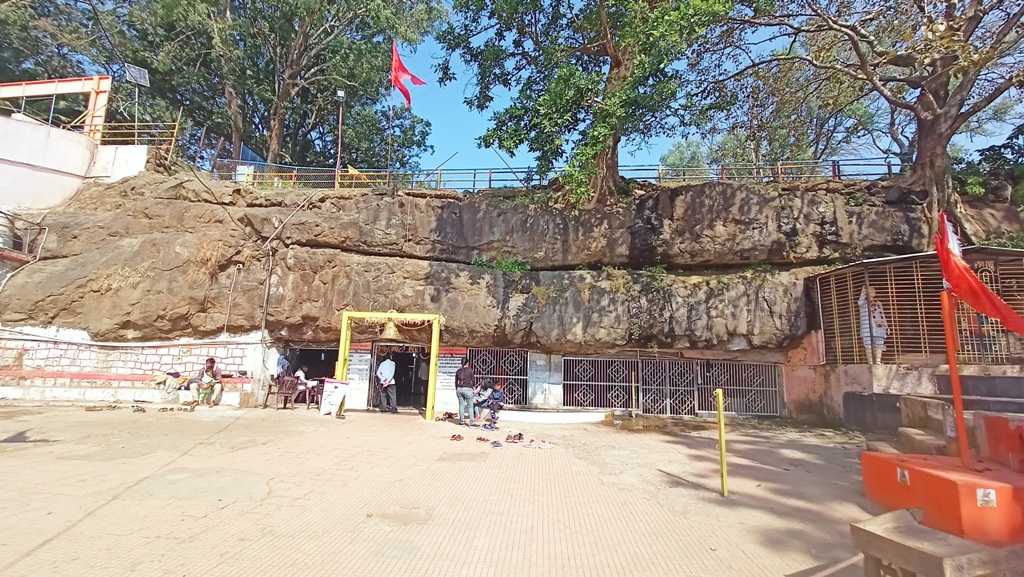
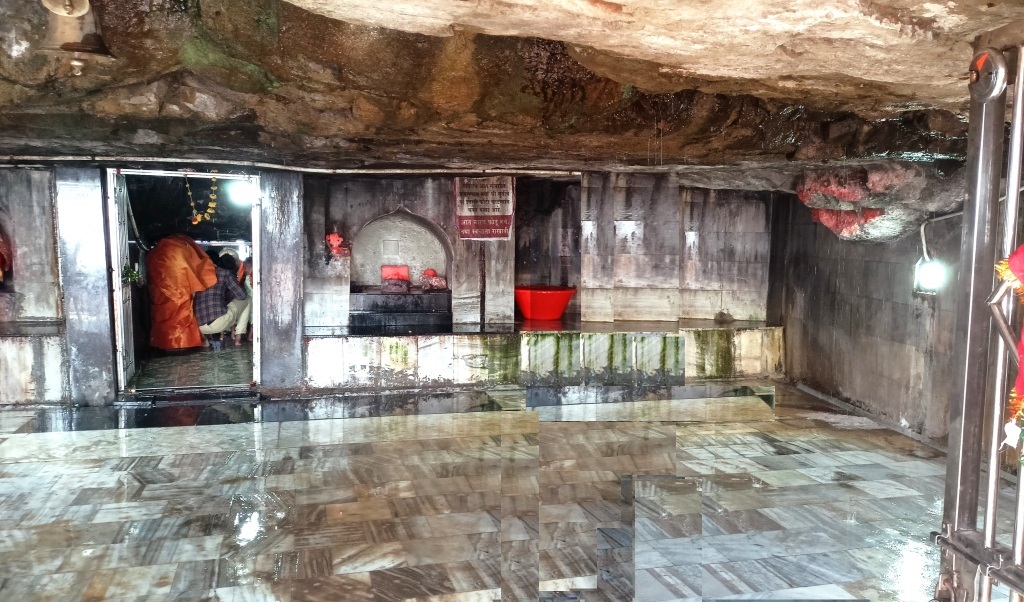
The temple is located under two slabs of massive rocks. Unique attraction of this temple is water trickling from its rock ceiling. It gives a feeling of holy water been sprinkled over you while waiting for your turn for ‘darshan’. The point offers some panoramic view of the adjoining hills and valleys. Be careful of monkeys as they tend to snack away anything from your hands.
Next PoI in our plan was 300 years old Gawilgarh Fort . Gavlis, who were leaders of the shepherd community in the 12th and 13th century are said to have built the fort. After the Gavlis the authority was passed to Gonds, Mughals and Marathas.
Unfortunately, the road from Devi point which leads to this Fort was under construction and traffic was restricted. We had to give this point a miss.
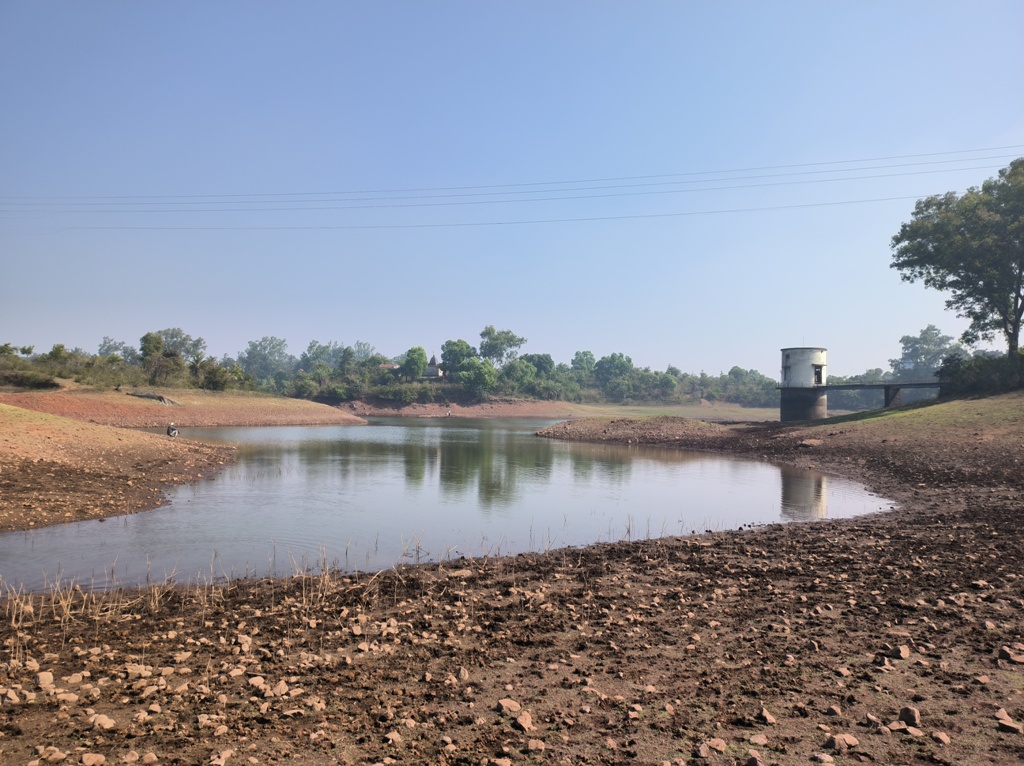
On our return drive, we stopped by – Kalapani lake. It is the water supply lake for Chikhaldara City. It has water treatment plant and other water supply structures. The lake was almost half dried up when we visited it. Except some peace and tranquillity, there is not much this point offers and can be skipped.
It was noon and we were left with the last point of the day – Botanical Garden. After parking our car we walked to Gurukrupa Family Dhaba for lunch. It is walking distance from the entry gate of the garden. Food was good and we loved the ‘rabdi’ (condensed milk) after lunch.
As a matter of fact, we later found that there are several joints in Chikhaldara selling ‘rabdi’. It seems to be the local specialty and is a must-try.
After lunch we walked to Botanical Garden. The garden is home to a diverse collection of plants, including many rare and exotic species. We enjoyed a peaceful walk along the well-manicured paths of the garden while admiring the colorful flowers, trees, and shrubs. The garden also runs a toy train.
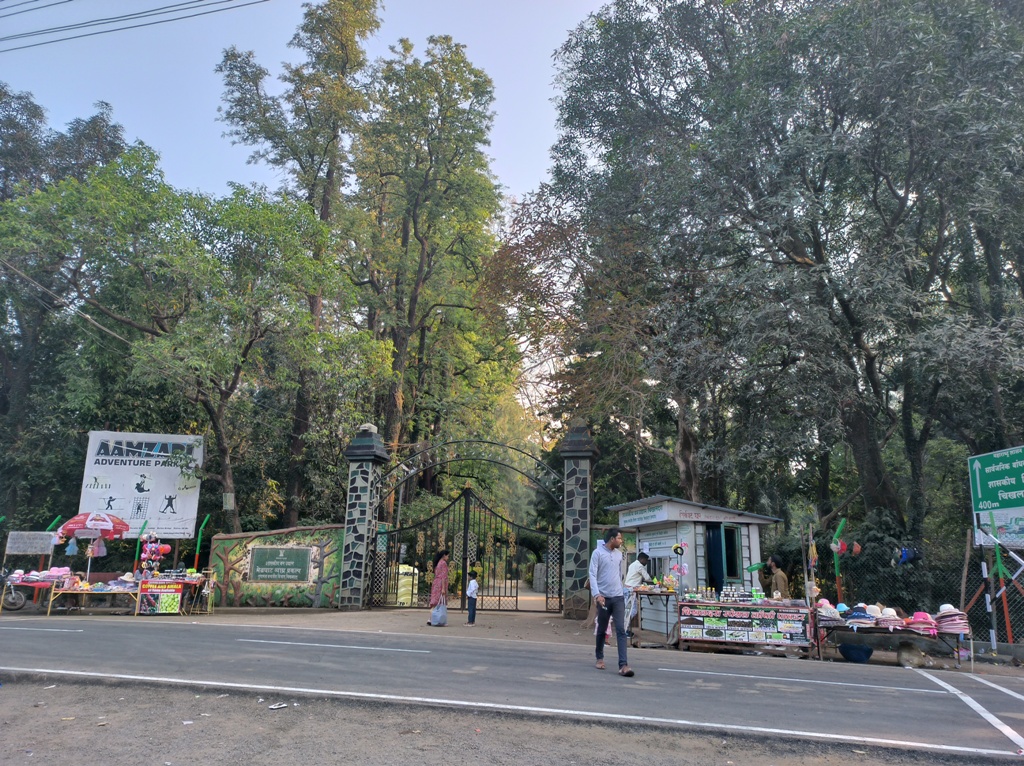
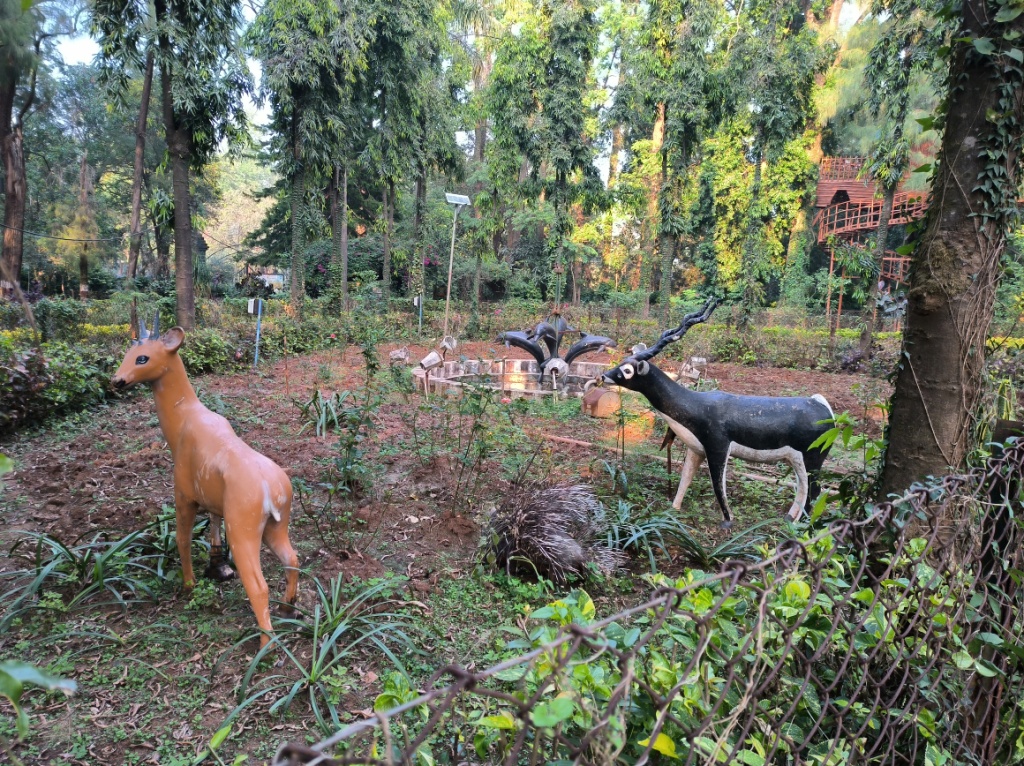
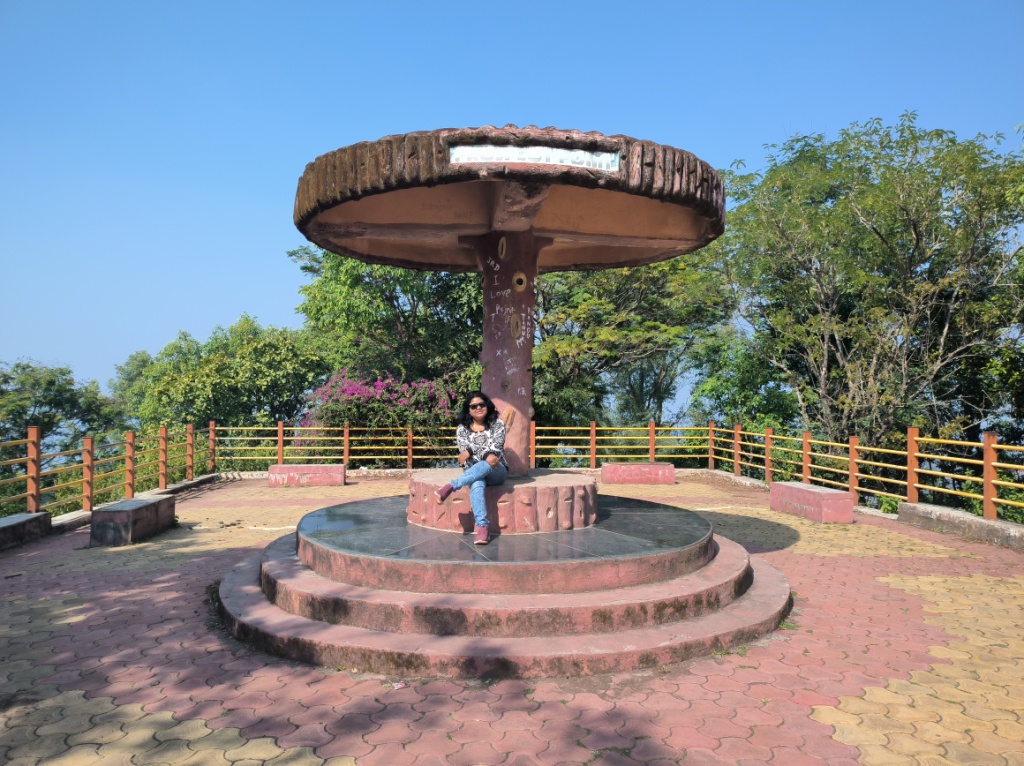
On our way back to our hotel, we stopped by Prospect Point which gives a beautiful view of Satpura Range.
Chikhaldara is a small and a sleepy hill station. Most of its restaurants don’t open during night or close early. We inquired for dinner at our resort’s restaurant and were told that it had to be ordered a few hours in advance.
Not wishing to step out for dinner, we placed a simple order of rice, daal and chapatis. The dinner fortunately did not disappoint when served.
Day 5: Drive from Chikhaldara to Nagpur: 222 km. 5 hours
&
Explore Nagpur
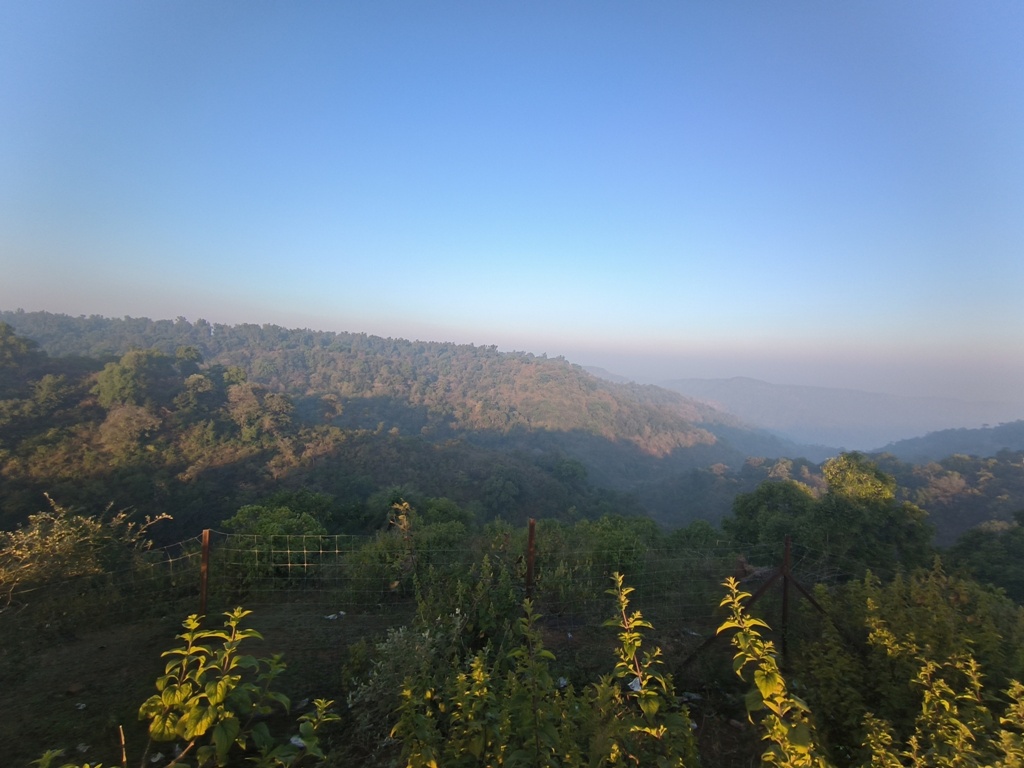
Day 5 started with an early morning walk to a nearby – Thakur Point. Mountains look surreal during early mornings when sun rays lighten up the upper parts of the hills while the base still seems to be gripped in the darkness.
We freshened up before setting out for day 5 adventure to Nagpur. We stopped for breakfast at the Main Market and then carried on with further journey.
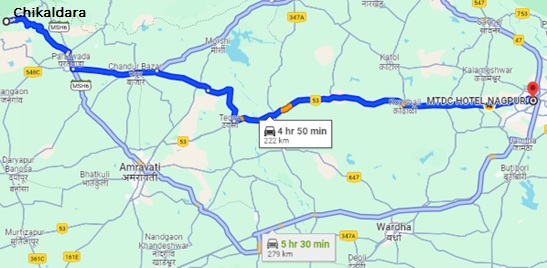
Nagpur is 225 km from Chikhaldara and takes 4 hours and 45 minutes of drive. The route followed was Paratwada >> State Highway 353J >> Chandur Bazar >> Ridhapur >> Ner Pinglai >> Tivsa. At Tivsa we joined NH 53 (Gujarat – Odisha highway) which drove us till Nagpur. Road conditions were excellent on the entire stretch. We reached Nagpur by 12 pm noon.
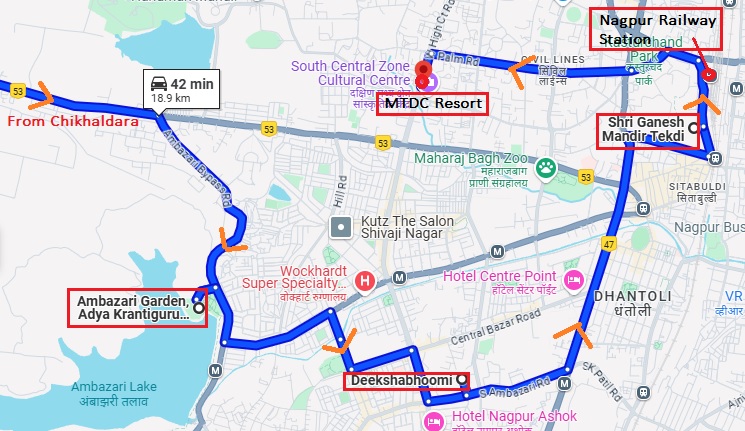
Nagpur is a major political centre in Maharashtra’s Vidarbha region and is also the winter capital. It is famous throughout the country as “Orange City” for being a major producer of oranges.
Places to explore on Day 1 of Nagpur were – Ambazari Garden, Deekshabhoomi & Shri Ganesh Mandir Tekdi.
We had booked MTDC resort for next 3 days at Nagpur. Plan was to explore Day 1 attractions before checking in to our hotel.
The first stop was Ambazari Garden and lake. It is famous for being the largest of the eleven lakes in the city of Nagpur and is surrounded by mango trees. The name Ambazari actually comes from “amba” which means “mango” in Marathi.
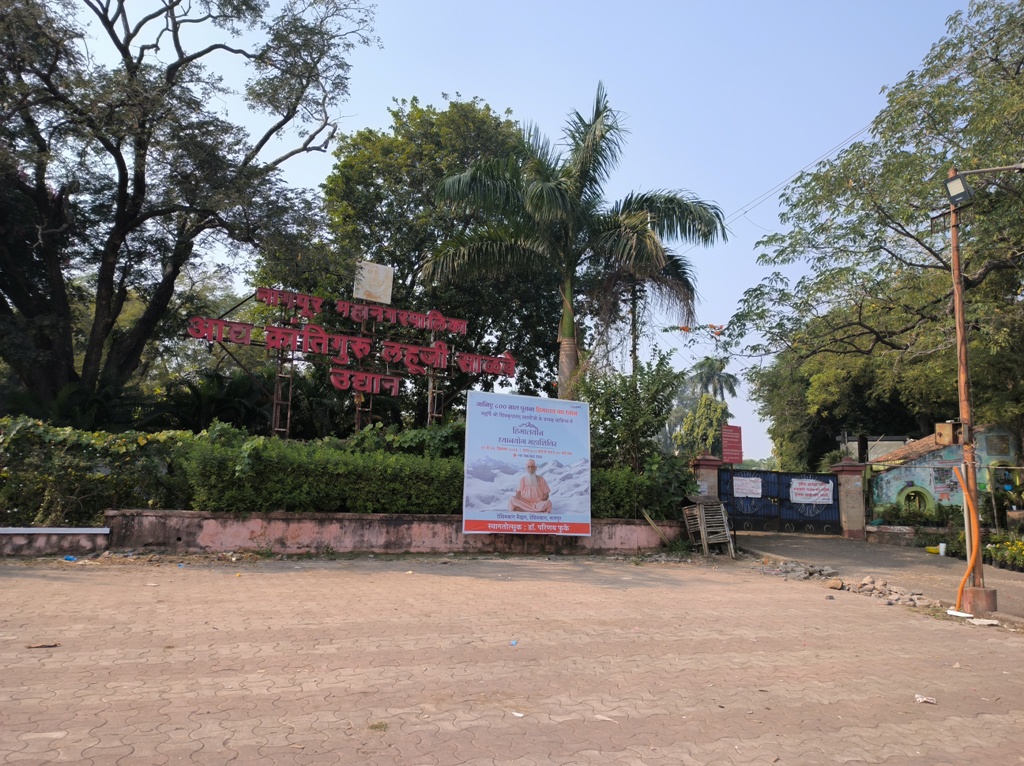

Unfortunately, after reaching, we found that it has been closed since Covid lockdown and was never reopened after that. We strolled along the lake and took a few pictures. As it was already noon, we decided to have lunch as everyone has started feeling hungry.
One of the best thing about Nagpur is that it is dotted with chain of Haldiram’s restaurants. You will find them almost in every nook and corner of the city. Their specialty is the famous Nagpur sweet item – ‘Orange Burfi’. In addition to sweets, most of them offer a fine spread of vegeterian dishes.
We ordered veg thali’s, which has – 2 rotis, daal, 2 sabji’s, boondi rayta, jira-rice and a sweet. All the items were moderately spiced and tasted good. The thali was definitely worth ₹300. Next we drove to – Deekshabhoomi
Deekshabhoomi means a place of spiritual awakening. It is the largest Buddhist stupa in India where Dr. Ambedkar embraced Buddhism along with thousands of followers. It is one of the most visited religious place for the Buddhists world over. It comprises a large two storied hemispherical buildings with gates resembling a Sanchi gate. The design of Deekshabhoomi resembles Sanchi stupa but is hollow inside. Under the dome is a large square hall with an image of Buddha placed in the center. It also displays a photo exhibition of the events in the lives of Gautama Buddha and Dr. Ambedkar.

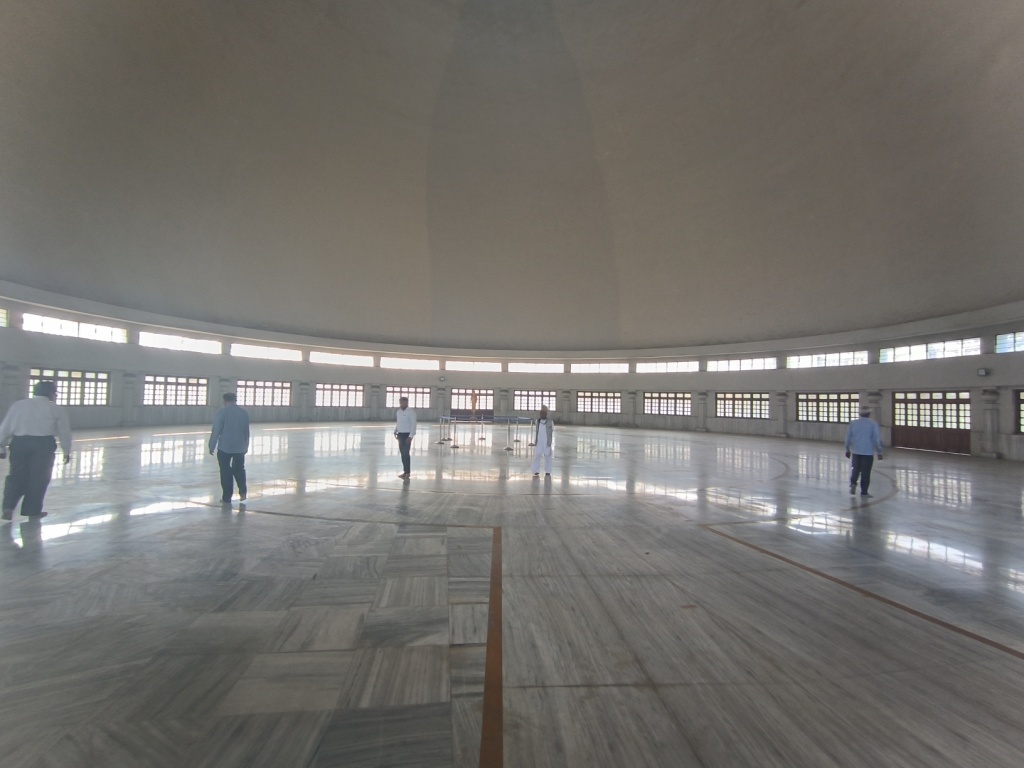
After spending about 45 minutes at Deekshabhoomi, we were headed to the next destination – Ganesh Tekdi Mandir.
This temple is situated near by Nagpur Railway station on a small hill. Hill is called tekdi in marathi, hence it temple takes its name as Ganesh Tekdi. Its one of the famous place of worship with high belief factor among local people. It’s considered one of the oldest temple and one of its kind because idol of Ganpati originated on stem of peepal tree and thus is considered swambhu (self originated).
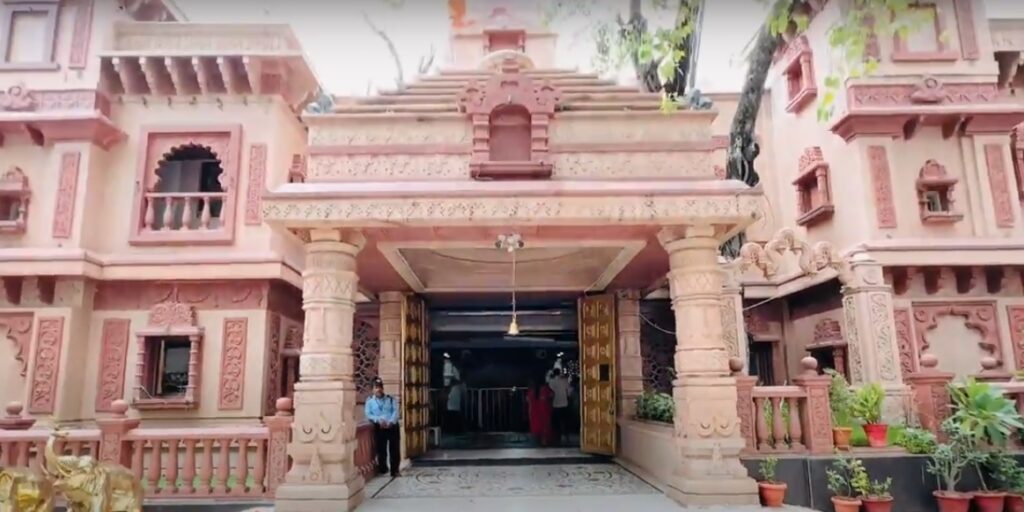
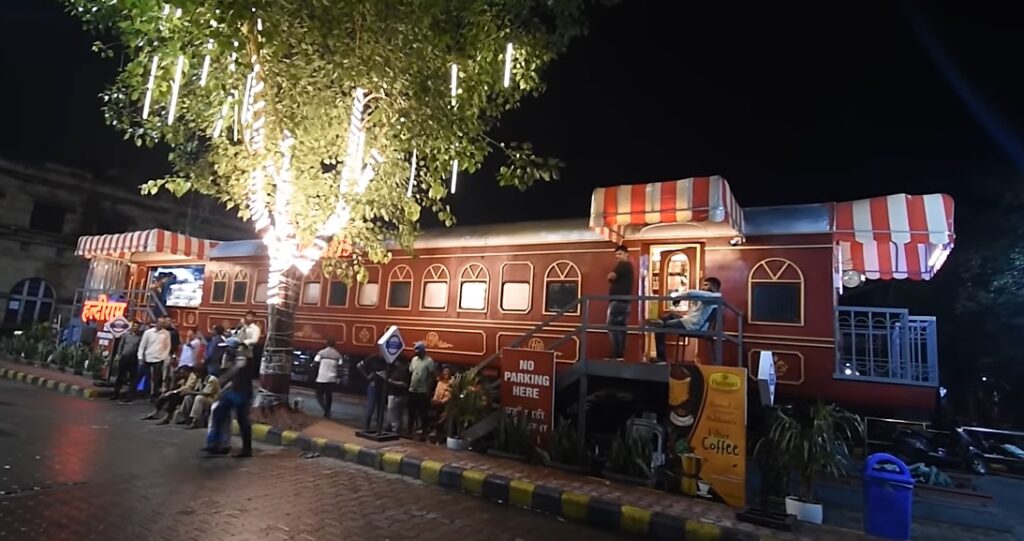
After taking blessings from lord Ganapati, we set the GPS to check-in to MTDC resort which was to be our temporary abode for next 3 days.
On our way to hotel, we passed by Haldiram’s train restaurant. As the name suggests, is a restaurant setup by Haldiram in a train bogy outside Nagpur railway station. Since it was a bit early for dinner, we skipped the visit. But if you are passing by the railway station or catching a train from Nagpur, you should give it a try.
15 minutes of drive brought us to MTDC resort. It is located at the heart of city near Bombay High court. The property is well laid out with ample parking space and a decent restaurant. After checking in, we relaxed for some time and then decide to go out for dinner.
It will be injustice to Nagpur if you miss its famous ‘matka rotees’ and ‘Saoji dishes’. ‘Matka rotee’ is an incredibly thin bread prepared from an almost watery thin dough. Skilled chefs (mostly women) shape the dough into extremely thin sheets and then then delicately affixed to the round surface of inverted heated matka (earthen pot). Once cooked, the rotiees are carefully peeled off from the surface and served hot. Though, I must say, I had a bit of concern with the hygiene aspect when I saw the cooks using their entire hands till shoulders to spread the bread on the pot. It was anyways, an experience to watch the unique process.
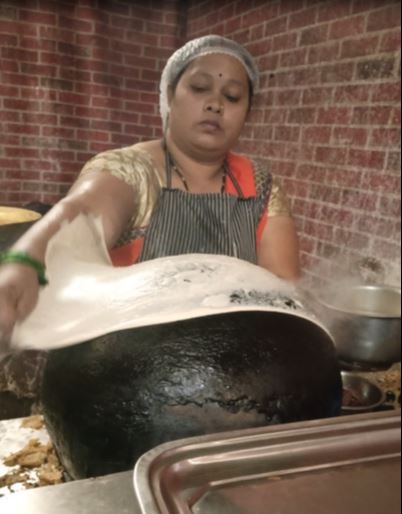


Saoji on the other hand is a spicy, flavourful, and mostly non-vegetarian cuisine. The Saojis were a small community of people who lived in the Nagpur region, and they were known for their war skills. They were the mainstay of the Maratha army, and had developed a high-energy, protein-rich diet to keep them strong and healthy during long battles. This diet eventually evolved into the Saoji cuisine, which is characterized by its bold, spicy flavors and the use of unique spices. The meat is cooked in a spicy gravy made from a mix of special Saoji spices, including black pepper, bay leaves, and dagad phool. Dagad phool, also known as Pathar Phool or Black Stone Flower is a type of moss found in the forests of Central India, and it is one of the key ingredients that gives Saoji dishes their unique flavour.

Taj Matka Roti on Central Bazar Road (Bajaj Nagar) had good reviews so we decided to give it a try. We drove to the restaurant, only to find that the place Google maps took was now ‘Tasty Matka Roti’.
We ordered Mutton Saoji and matka rotees. Dishes were moderately priced. Saoji costed ₹350 and rotees were ₹20 each. The mutton was cooked to perfection.
The mutton gravy was thick, flavorful, and packed with spices. It had a strong and aromatic taste that paired excellently with matka rotees.
I would highly recommend this place if you are out searching for a good place to eat in Nagpur. After a wonderful dinner, we returned to our hotel and called it a day.
Day 6: Explore Nagpur
Second day at Nagpur started with a leisurely wakeup and a complimentary breakfast at in-house restaurant.
Before I go to the details of the day’s itinerary, I would like to give a shout to the traffic of Nagpur. The City has got an excellent network of wide roads with very well organized traffic. I don’t recall encountering a traffic jam anywhere during our 3 days of stay. The city gives a vibe of well-planned cities like Chandigarh or Bhubaneswar.
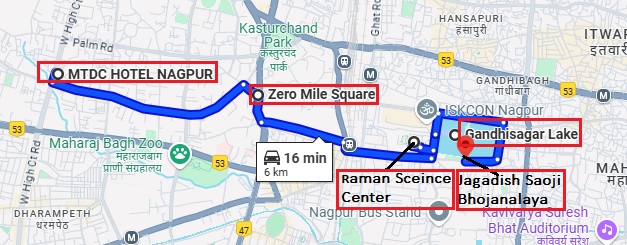
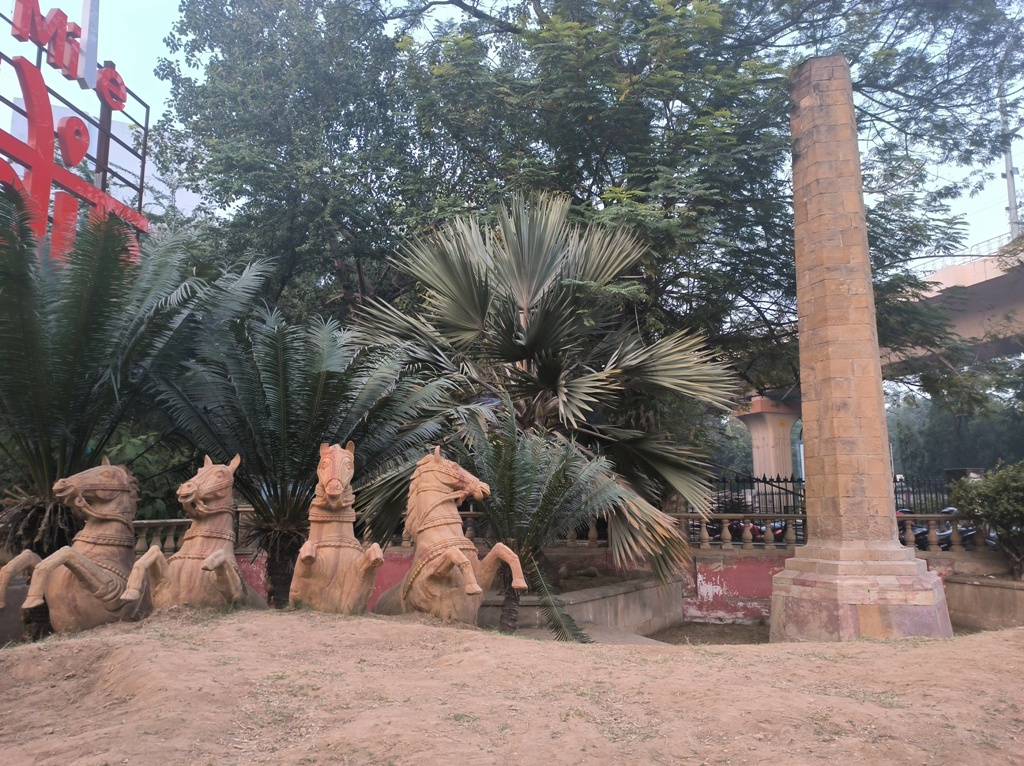
Day 6 was scheduled to explore the city’s remaining attractions and iconic landmarks. We were to visit – Zero Milestone, Raman Science Centre, Gandhisagar Lake, Narrow Gauge Rail Museum and Itwari Market.
5 minutes’ drive from MTDC brought us to the first stop – Zero Mile. It’s a small enclosed area at the corner of cross-roads and can easily be missed out in the first sight. It was built by the British during the Great Trigonometrical Survey of India in 1907. It consists of a pillar made up of sandstone. Four horses were added later. It was supposed to be the center of undivided India. However, after India’s partition, the center of the country shifted slightly northeast wards into what is now Madhya Pradesh.
5 minutes’ further drive from Zero mile is Raman Science Center. Named after the renowned Indian physicist – C.V. Raman, it is a popular science museum dedicated to promoting scientific awareness.
It features a wide range of exhibits and interactive displays to make science more accessible to visitors. It also houses a planetarium and holds regular 3D shows which should definitely not be missed. Timings of the museum is 11:30 am – 7 pm and entry ticket costs (Science Center + Planetarium + 3D Film Show) ₹70.
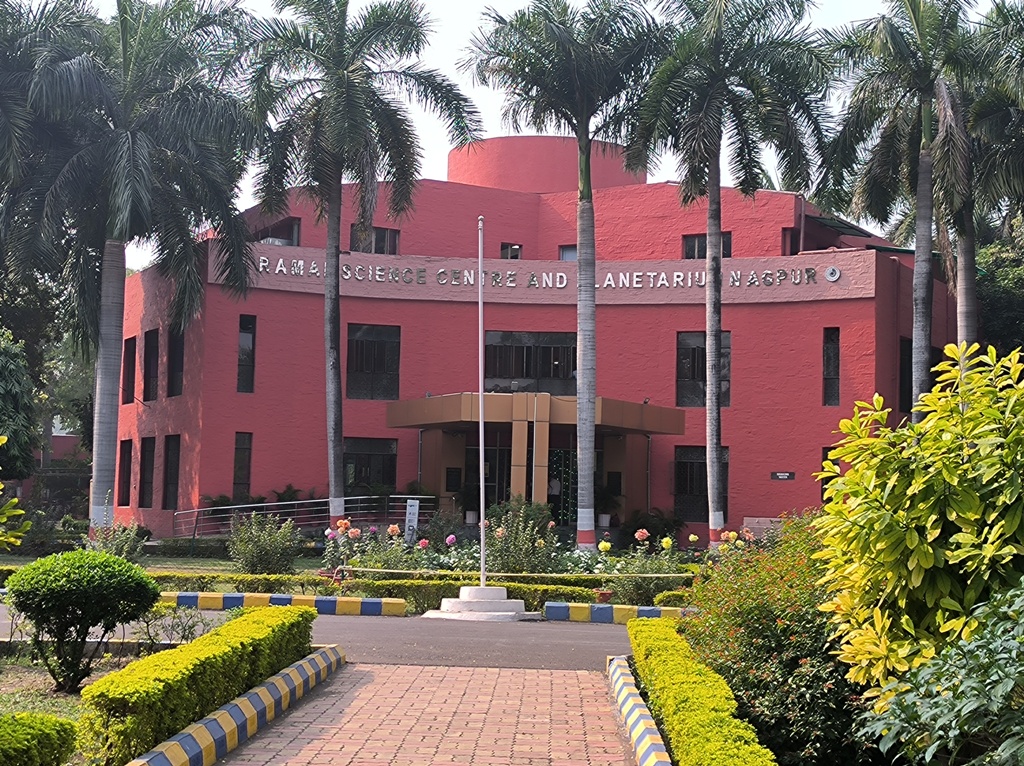

A few minutes of drive takes to you to Gandhisagar Lake. The Lake is said to have existed for more than 275 years. It was established as a source of water supply by Chand Sultan, the then ruler of Nagpur. Online resources claim that the garden adjoining the lake opens 6am-6 pm, but we found entry gate to be locked in the noon.
Just opposite to Gandhisagar lake is – Saoji Jagdish Bhojnalaya. It is another most recommended restaurant for Saoji dishes. It has a casual, no-frills atmosphere but it’s more about the food than the décor of this place. We ordered mutton and chicken Saoji thalies. The restaurant did not serve ‘Matka rotees’ so we had to content with bhakries and rice. Both the dishes were spicy and tasted good. The place is quite popular with locals and foreigners.
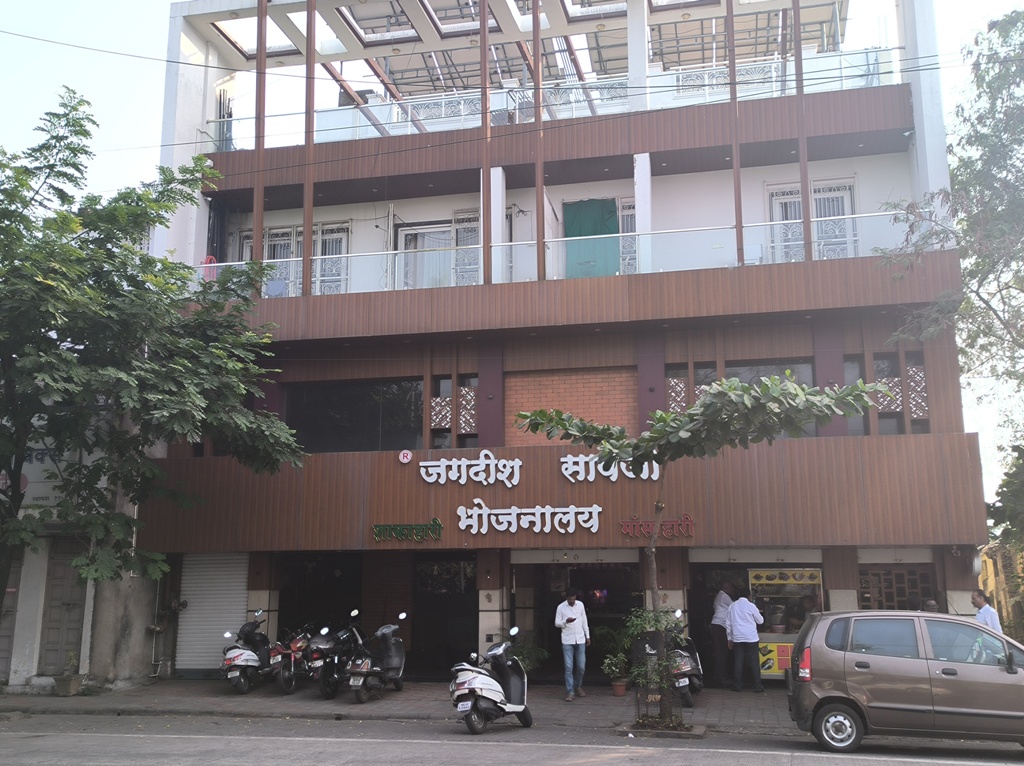
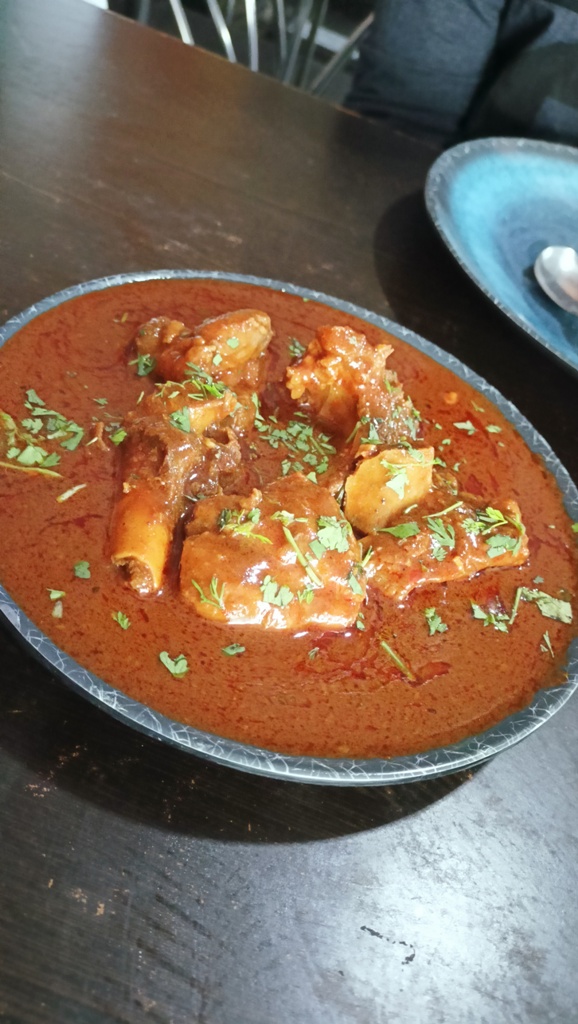
After lunch we drove back to our hotel and have some rest. Evening was scheduled for Rail Museum and Itwari Market. Itwari Market lies in a congested area and driving there could have been a challenge, so we decided to use Metro train.
We hired an OLA to drive us to – Narrow Gauge Rail Museum. The museum is about 5 km from the MTDC and takes about 15 minutes. It show cases old & heritage articles of Indian Railway, old steam engines, coaches and many more things related to Narrow Gauge Railway. It also runs a Toy Train around the museum. It is a must visit place for train enthusiasts.


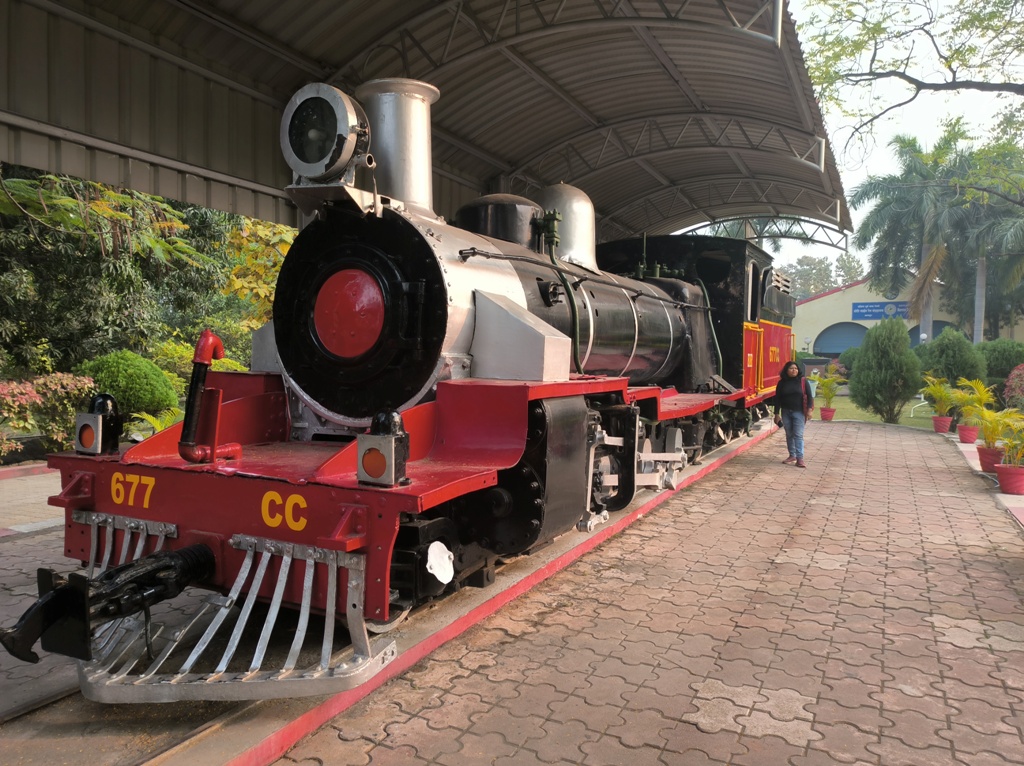
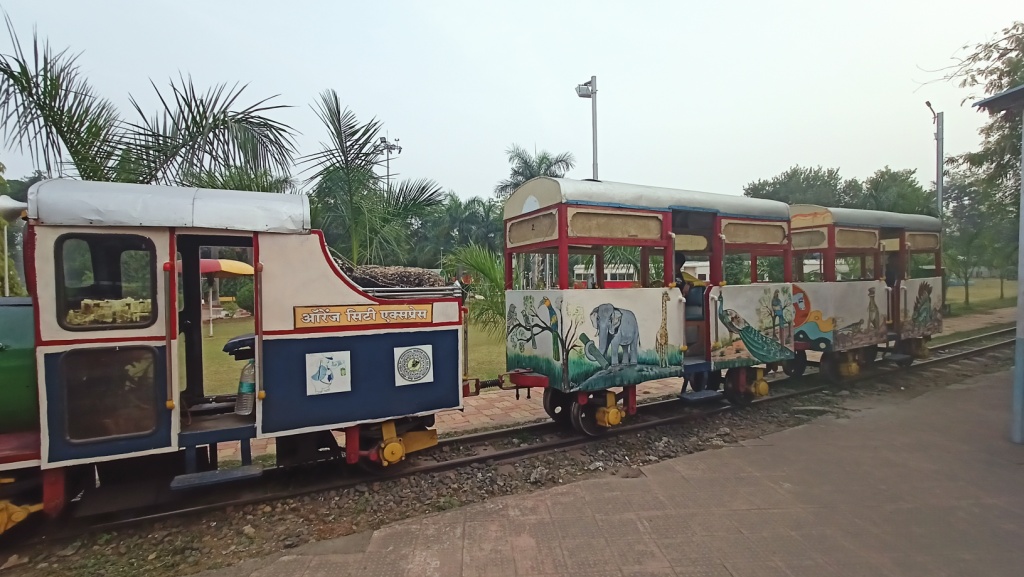

After an hour well spent in the museum, we walked to the nearest Metro station – Kadbi Chowk (Orange line). We hopped to Aqua line at Sitabuldi interchange station to take us to Chilori Square.
A few minutes of walk from Chiroli Square is Itwari Market. This market is the ‘chandni chawk’ of Nagpur. It has wholesale shops selling garments, imitation jewelry, gold ornaments, dry fruits and groceries. You name it, and you will find it here. Once tired of window shopping, we stopped by a couple of street food vendors to try out some local delicacies.
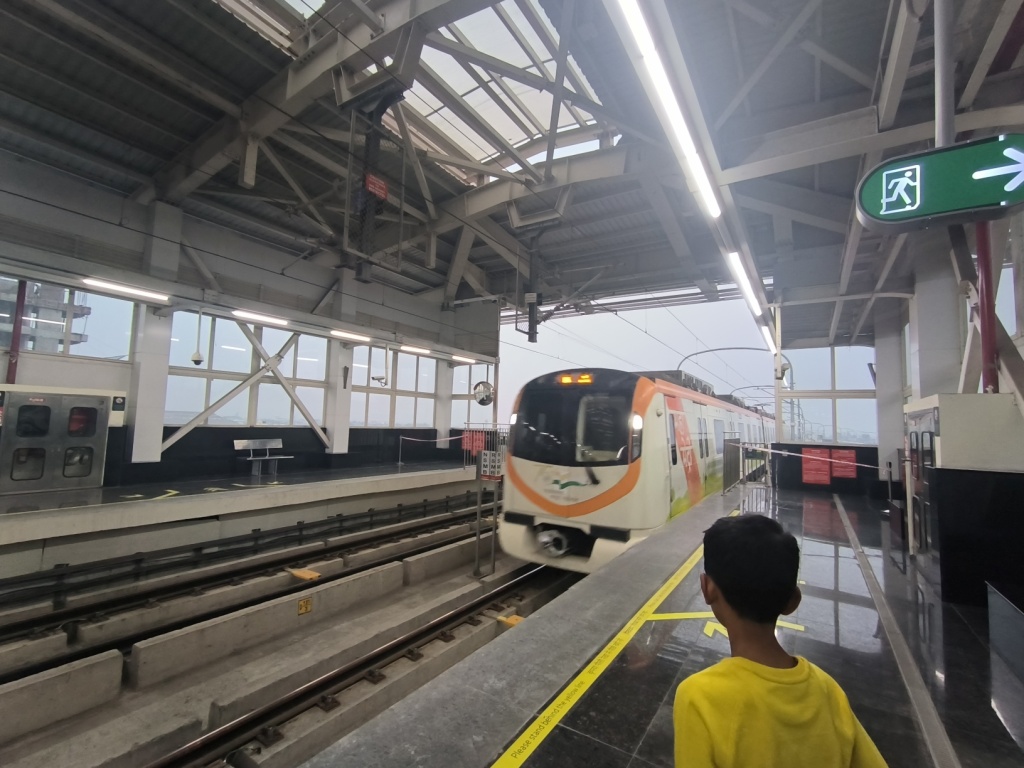
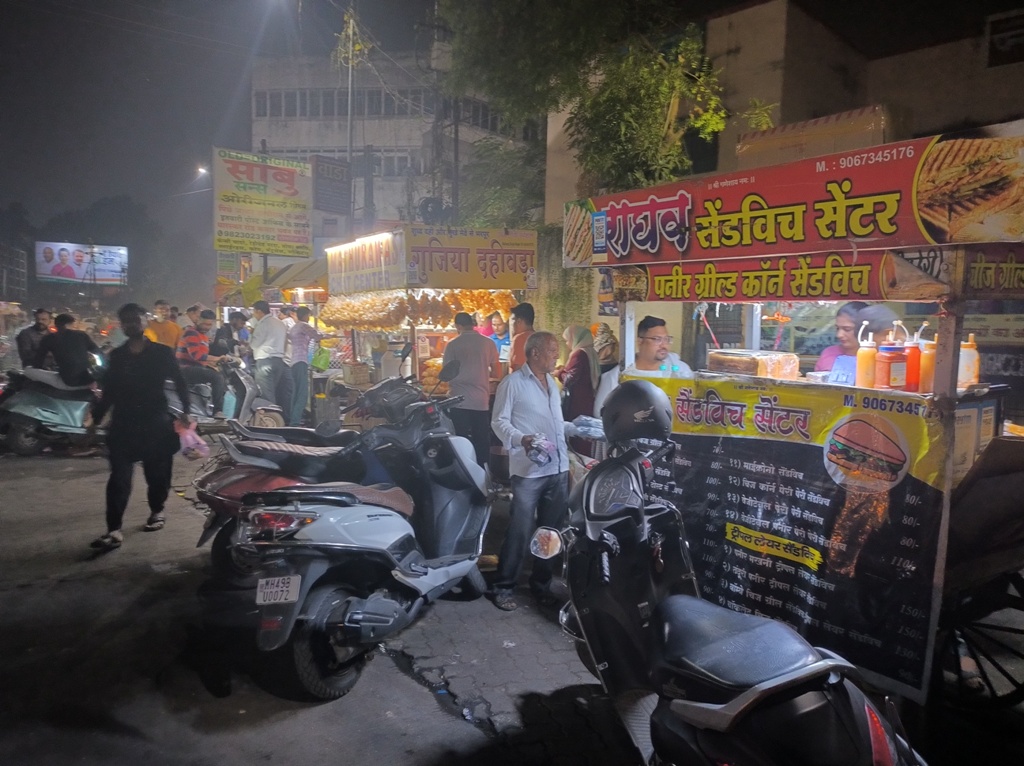


Next day, we were to leave for Pench at 4:30 am. We did not expect breakfast that early, so we bought some bread, butter and cheese to carry with us. After spending a few more hours at Itwari market, we took an OLA back to our hotel and called it a day.
Day 7: Day Trip to Pench Tiger Reserve & Ramtek
Third Day at Nagpur was scheduled for an excursion from Nagpur. We had booked an early mornig safari at Pench Tiger reserve and trip to Ramtek and Dragon Palace on the way back to Nagpur.
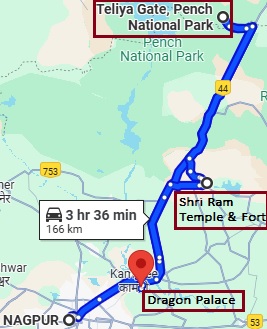
Before I go into the details of our Safari, below is some important information about Pench.
- Pench National Park is spread across the border of Madhya Pradesh and Maharashtra. It is about 90 km and takes 2 hours of drive from Nagpur. The park is named after the Pench river which flows through it.
- Chances of sigting tiger is more on the MP side as compared to Maharashtra.
- The MP side is divided into 3 Core Zones and 3 Buffer Zones. 3 gates in the core zones are – Turia, Karmajheri, and Jamtara and 3 gates in the buffer zones are – Rukhhad, Khawasa and Teliya.
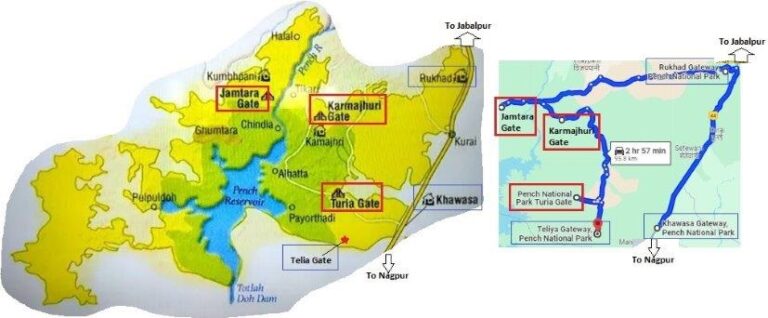
-
- Turia (Core) – It is the most famous gate. Maximum Tiger Sighting happens in this zone. It lies almost on the border of MP and Maharashtra. Most of the resorts are located towards this zone.
- Karmajheri (Core) – This gate is less busy and with limited accommodation. Forest rest houses are also located at this gate. This part of the forest is majorly covered with Teak Trees.
- Jamtara (Core) – This is the third gate of the park and offers a limited area of the park to explore.
- Rukhad (Buffer) – As this area is in the hilly region. Rukhad is also a crucial Tiger corridor for Pench and Kanha.
- Khawasa (Buffer) – This buffer is also known as the Wolf Sanctuary and one can experience night safari in this area. The area is mostly open wooded forest which is preferred by animals like wolves, foxes, porcupines, Owls.
- Teliya (Buffer) – Known For its wolf sighting, Black Panther and Leopard sightings. It also offers sightings of Barking Deer, Chowsingha and Blue-Bull Antelope
- All National Parks in MP require you to book a permit. I recommend to book it at least 3 months in advance. It can be done online at – https://forest.mponline.gov.in/ . December being a peak month, slots fill up fast. In 2023, the charges of permit were ₹600/person. Try to book it for the core zone (preferably Turia gate)
- You need to book safari jeep separately. It can be booked directly at the venue or can be done online from https://www.penchnationalparkonline.in/online-pench-safari-booking.html . I will recommend to book it on the spot as I found the online prices a bit high.
- Don’t forget to carry ID proofs which you mention at the time of booking permits
- Make sure to pack some woolens (jacket and cap at least). Early morning safari in open jeeps is pretty cold during winters (Nov-Jan).
- There is no network coverage inside the sanctuary. Carry sufficient cash.
We had booked an early morning safari slot (6:30 – 10 am) at Telia buffer zone. The core zone permits were not available even a month in advance. Keeping in view 2 hours of driving time, we left our hotel at 4:30 am.
It was pitch dark while driving through empty roads of Nagpur. We zoomed out the city in a jiffy but once on the Nagpur – Japalpur highway, we were greeted with thick pockets of fog which slowed us down a bit. Highway was in an excellent condition till Forest Naka at Manegaw Tek from where Telia gate is 7 km further to the left. I was a bit apprehensive about GPS directions in forested area but luckily Google maps navigated us fine till the entry gate.
After checking our permits an ID proofs, we were allocated a jeep along with a ranger. The safari cost was ₹4000 in 2023.
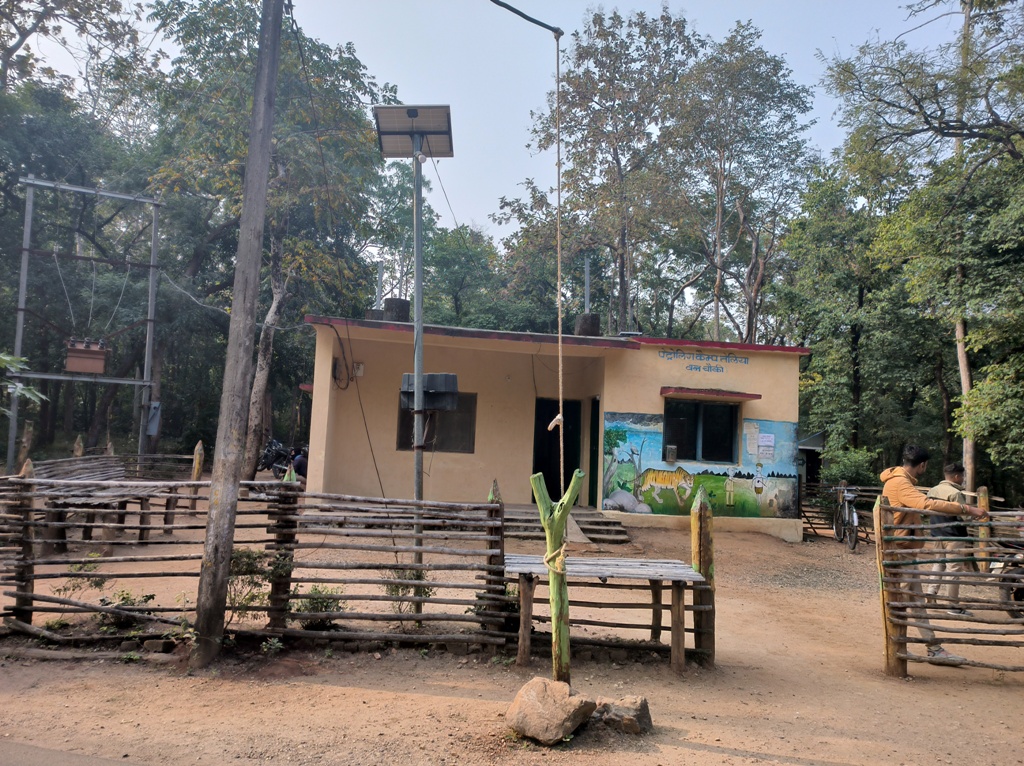
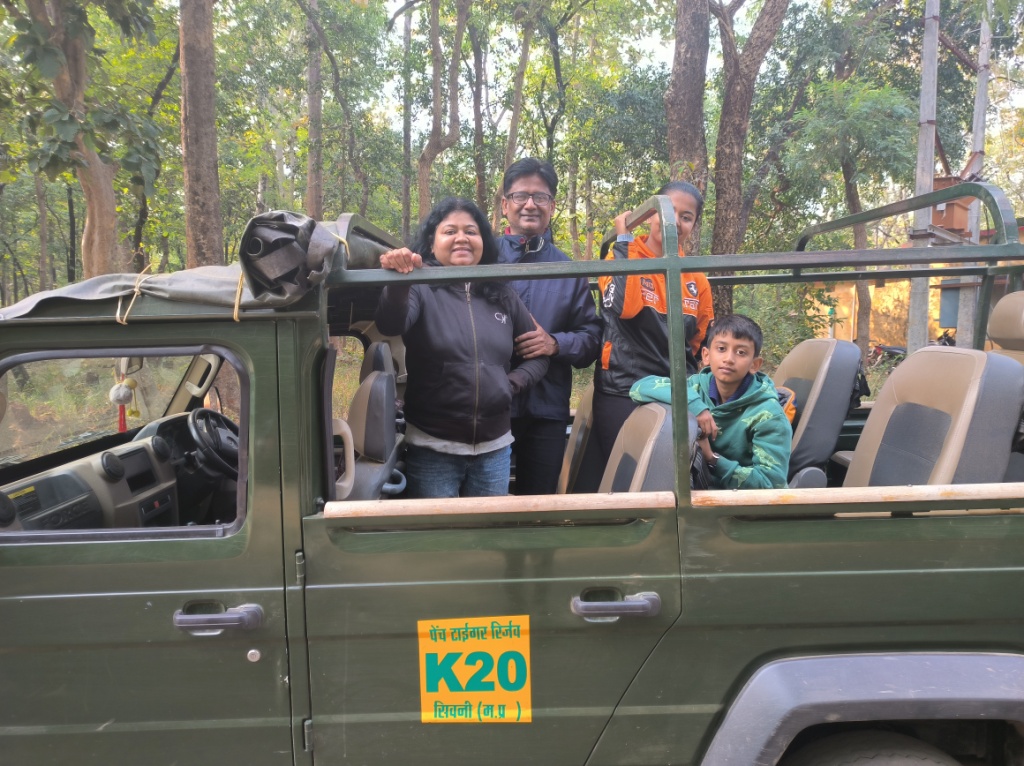
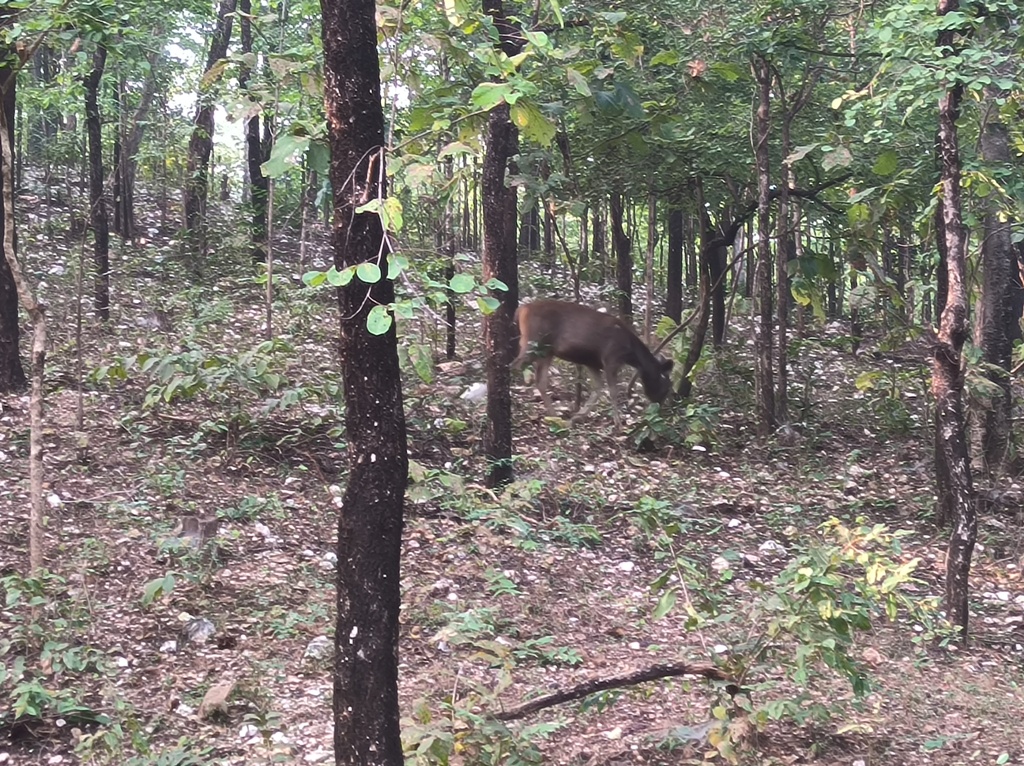
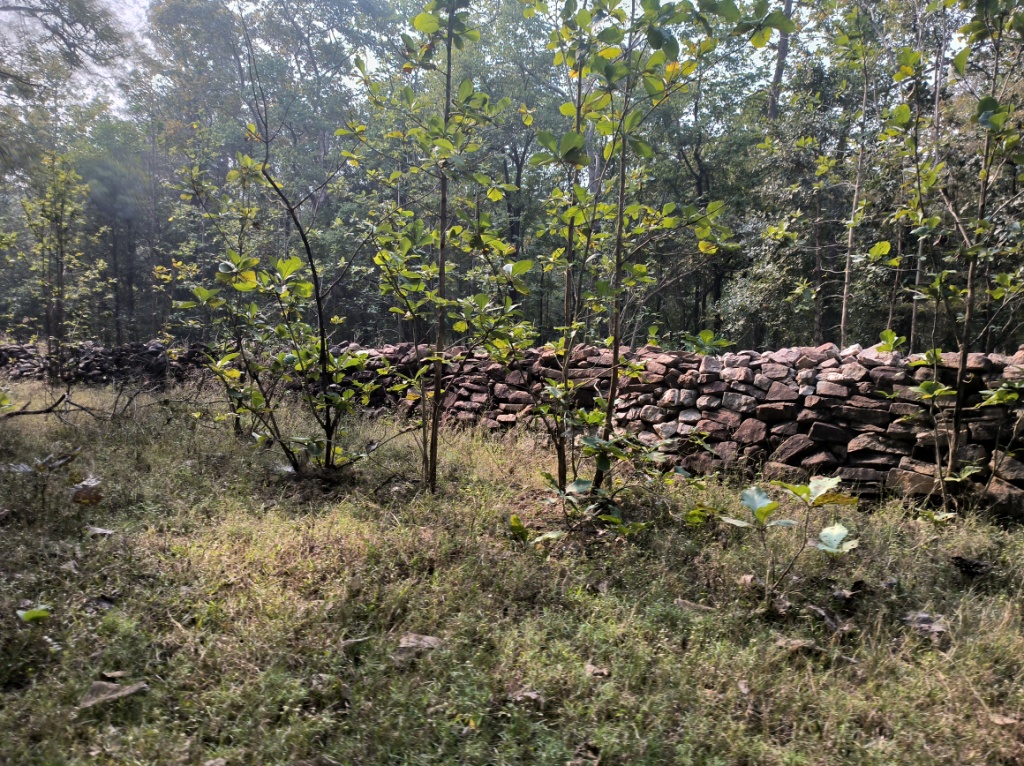
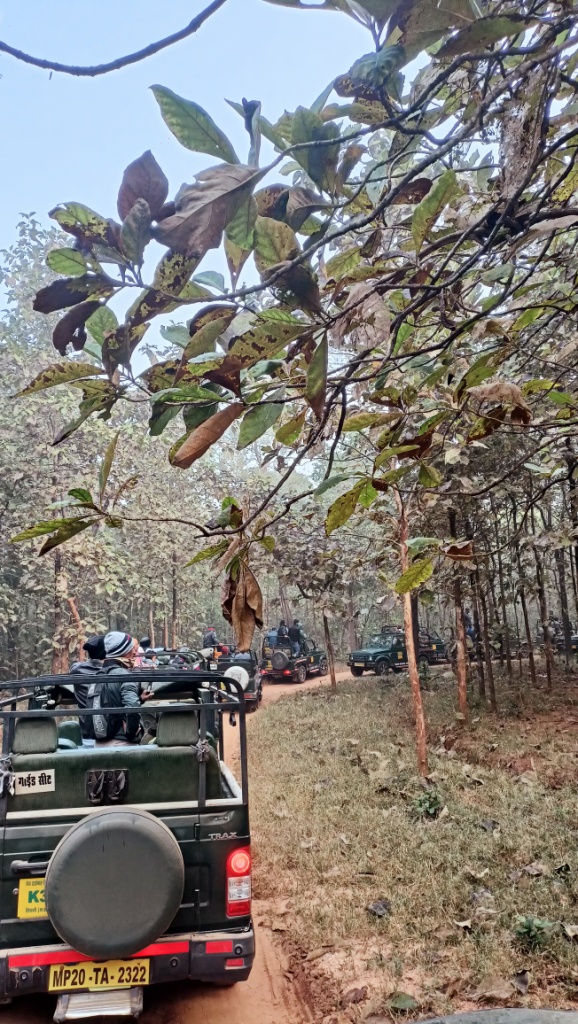
We started our drive into the forests on our 4 X 4 drive open jeep and realized how cold mornings can be in forests. Though, we were wearing jackets, we could still feel the chill hitting our bones and wished we had brought woolen caps and gloves. During the Safari, we got to see – Gaur, Spotted Deer, Sambar, and few monkey species. We were yet to see the tiger when our ranger got a call for a possible tiger sighting. We all rushed to the spot only to find a long queue of jeeps already waiting for the tiger to show up. The rangers were following the calls which monkeys make when they see a tiger. We waited for 15 minutes in utter silence. Unfortunately, the tiger decided to be elusive that day.
The jeep stopped for a tea break at a makeshift restaurant on the periphery of the sanctuary. We had tea along with bread we had bought with us. The restaurant also had an option of poha.
We spent about 3 hours exploring the different sections of the zone. Our ranger showed us tiger pug marks and explained how to differentiate between a male and female by looking at them.
By 9:30 am, we were dropped back to the Telia gate from where we had started.
Our next destination was Ramtek which is 48 km on return drive to Nagpur and takes 1.5 hours. There are two places to visit there – Shantinath Digambar Jain Temple and Ramtek Temple.
Shantinath Digambar Jain Temple – It is dedicated to the sixteenth Tirthankara of Jainism – Lord Shantinath. Devotees from all around the country come and visit the temple where the idol of Lord Shantinath is installed. There are fifteen other shrines and temples along with the main temple. Newly build Manstambha made of red stone catches your attention. Kalidasa in his lyrical poem Meghaduta has mentioned this temple a couple of times.
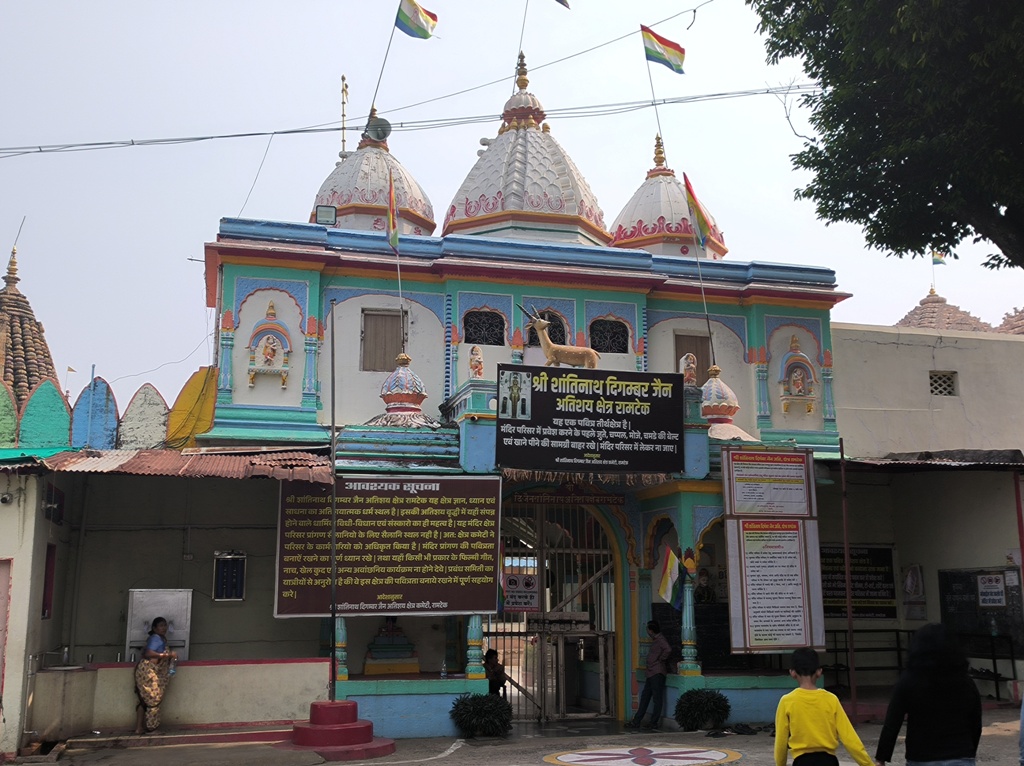

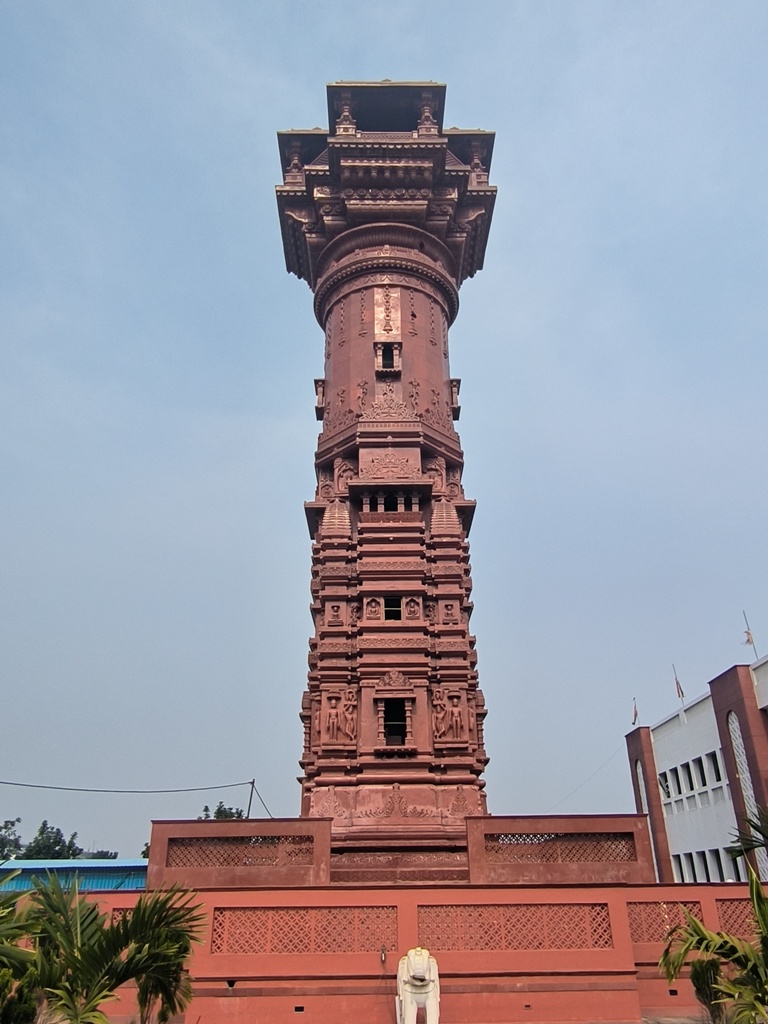
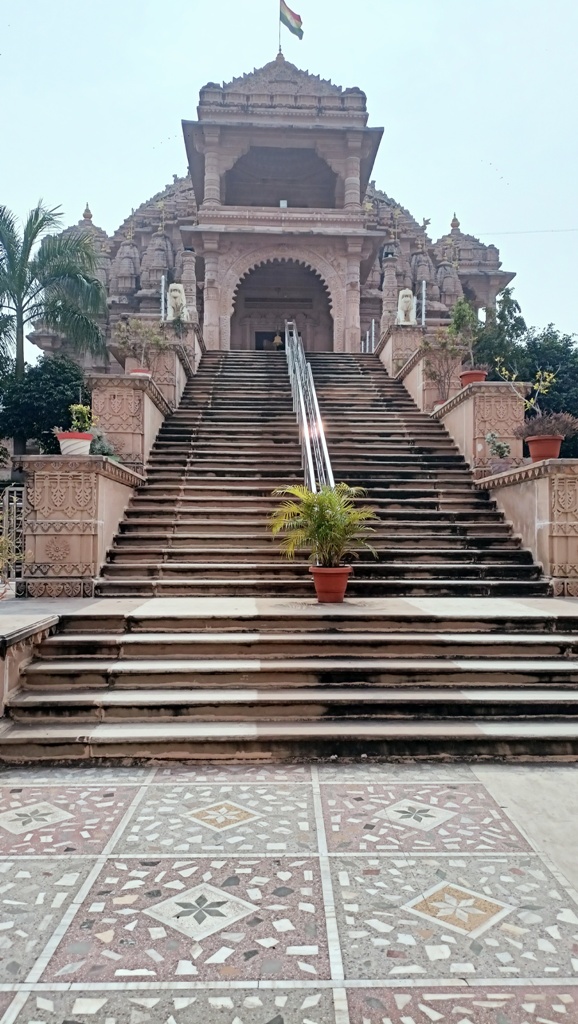
Ramtek RamTemple – 15 min drive to a small hill top takes you to this historic temple of lord Ram. It is believed that it was the place where Ram rested while he was in exile. ‘Tek’ means vow in local language, hence the word Ramtek means ‘Vow of Ram’. Thus it is believed that whoever takes a vow at Ramtek is blessed for its fulfillment. Great poet Kalidasa had written Meghaduta on the hills of Ramtek.
A short drive to the hill top leads you to this temple where ample paid parking is available. On the way to the temple, there are several food selling salted berries, nimbu paani, soda. You also get to see pavilion with a huge statue of Varaha which is considered boar-avatar of Vishnu. Beware of monkeys which try to snatch away things you are carrying. View of the city looks amazing from the temple. While returning, we stopped by a food stall and had bhakris with daal and wangi (brinjal) bhaji.
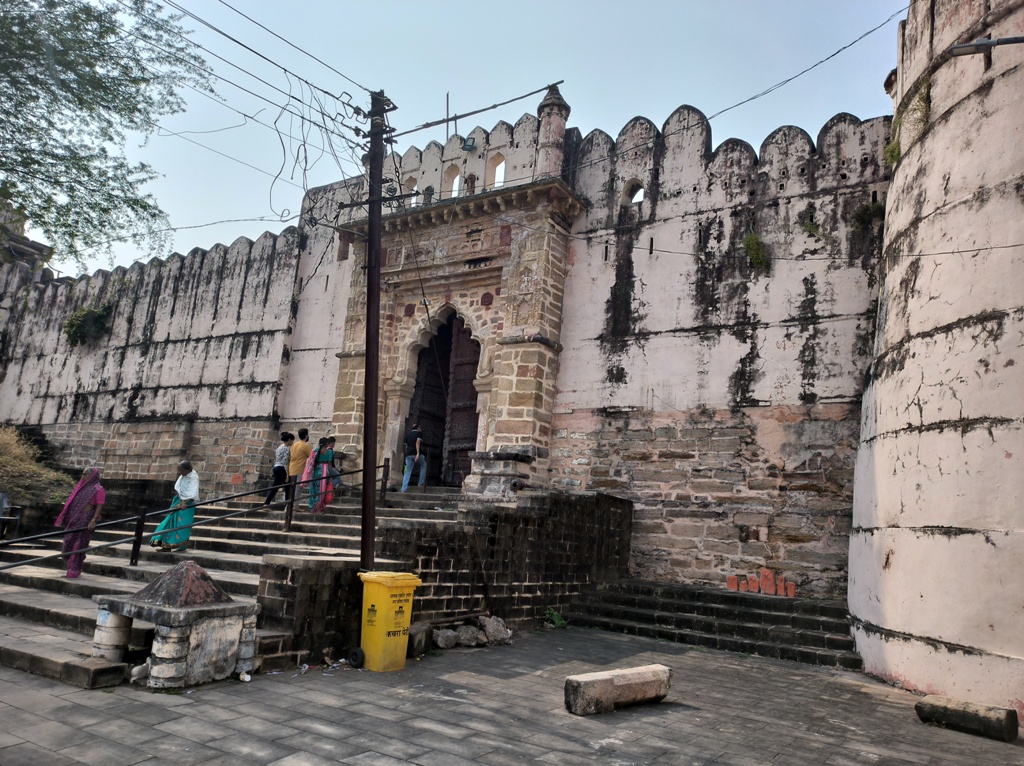
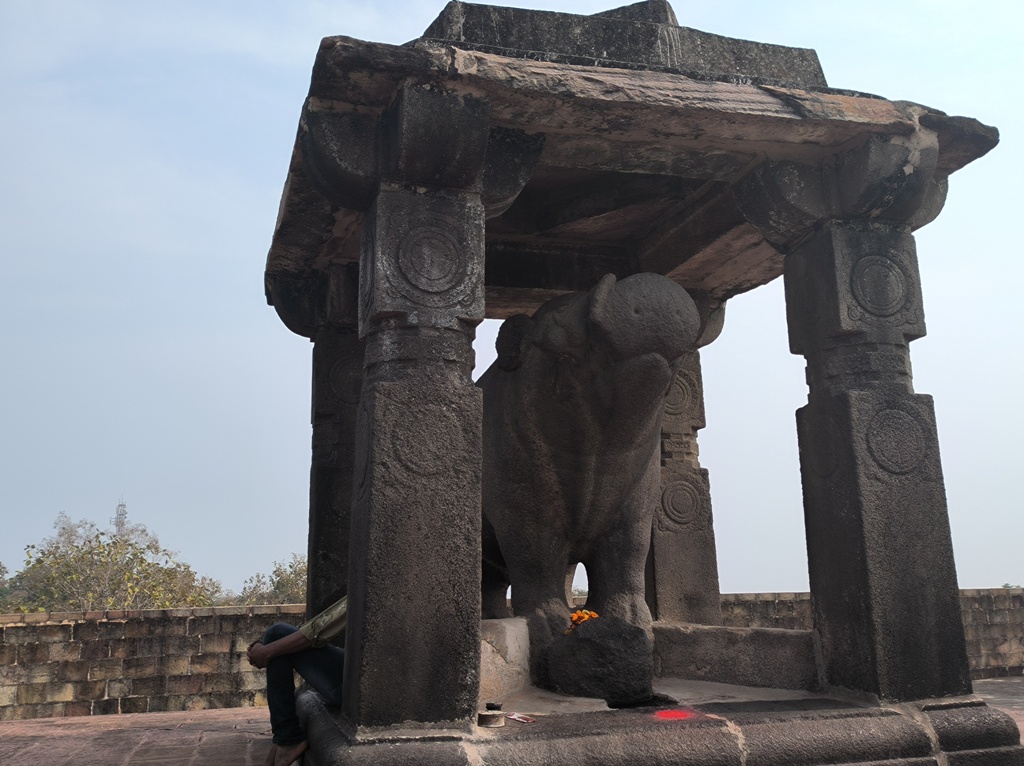
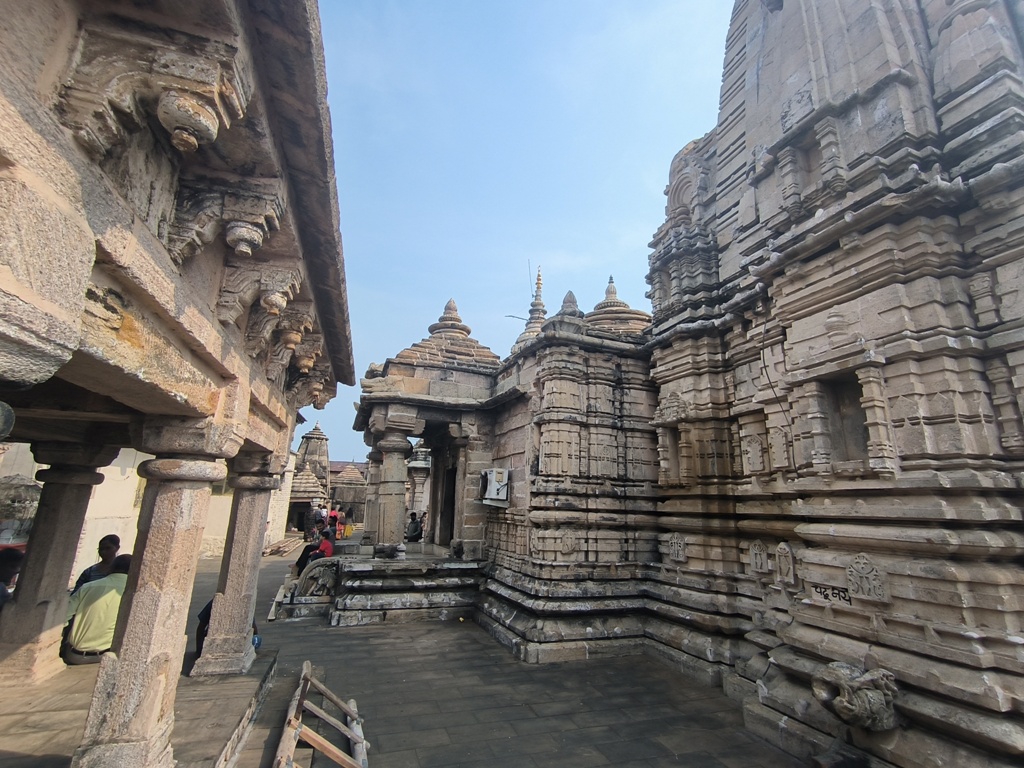
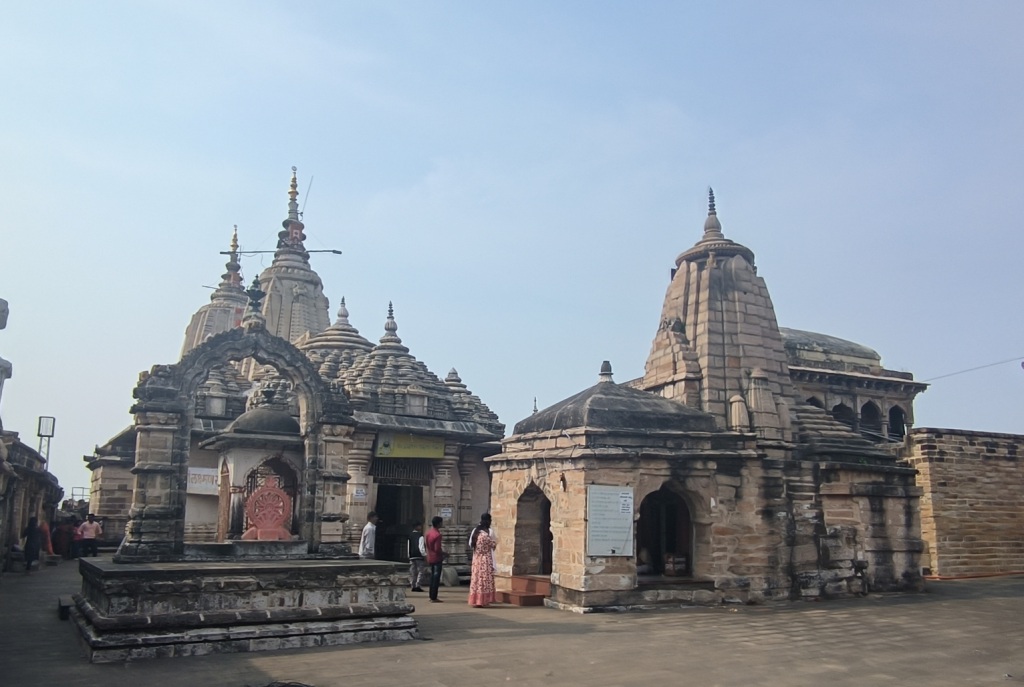
It was noon by the time we finished visiting Ramtek. 34 km. further lies another point of attraction – Dragon Palace Temple. This Buddhist Temple is situated on the outskirts of a village called Kamptee, which is around 20 Kms from the Nagpur city, and it takes around an hour to reach this place. The temple is newly built in 1999 with the funds from Japan. It has a huge sandalwood statue of Buddha and the premises are done beautifully with well-groomed gardens and an overall aesthetic appearance.
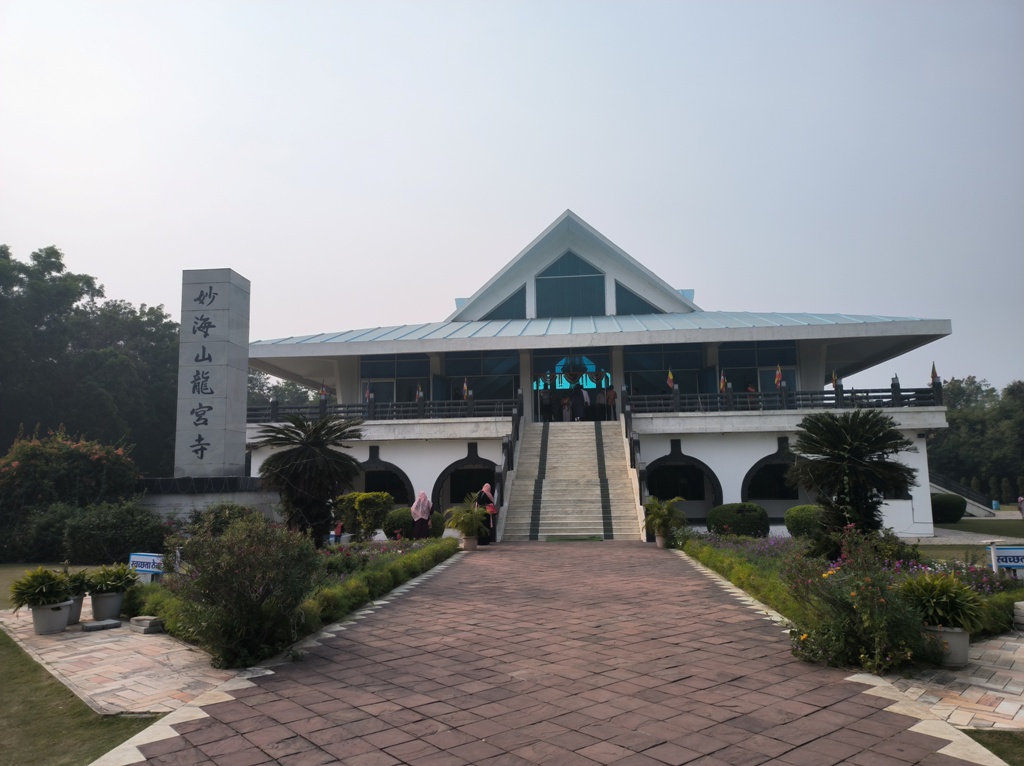

After spending some time at the temple we drove back to our hotel. Last day at Nagpur gave us a bit of everything – started day with a jungle safari and then concluded by visiting Jain, Hindu and Buddha temples. It had been a long day and it was time to unwind. We had an early dinner at the hotel’s restaurant and slipped into our beds.